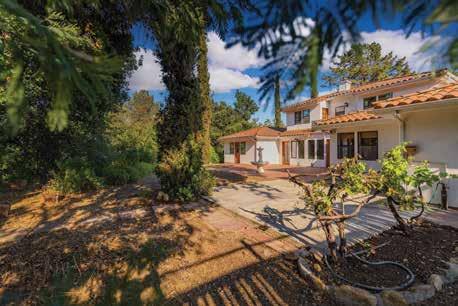PLAYWRIGHT/ACTOR HAS SCENE IT ALL
SALAS ASKS ‘WHAT’S OUT THERE?’
DOG’S GONE TO CARMEL
SANDHILL CRANES RETURN TO CARRIZO
$6.95


PLAYWRIGHT/ACTOR HAS SCENE IT ALL
SALAS ASKS ‘WHAT’S OUT THERE?’
DOG’S GONE TO CARMEL
SANDHILL CRANES RETURN TO CARRIZO
$6.95

EAST END
MAGIC $5,200,000 FOR SALE

Built in 1922, this iconic Spanish home is part of the original Whale Rock Ranch famous for its giant outcropping of whaleshaped rock, considered to be the largest Chumash carving in the west. Nestled in the prestigious East End of Ojai up a meandering road, this compound of three separate structures is situated perfectly on a two-acre private park-like setting inhabited by majestic oak trees, exotic cactus gardens, hand-crafted stone walls and views. The two story main house is a 3 bedroom, 2 bath with Italian single stone carved marble sinks, AGA appliances, and loads of natural light. Vaulted beamed ceilings and massive rock fireplace complement the great room, a perfect mix of elegance and simplicity that creates a calming environment. A main house, pool house and a studio with bathroom and gas fireplace ready to become whatever you dream it to be.



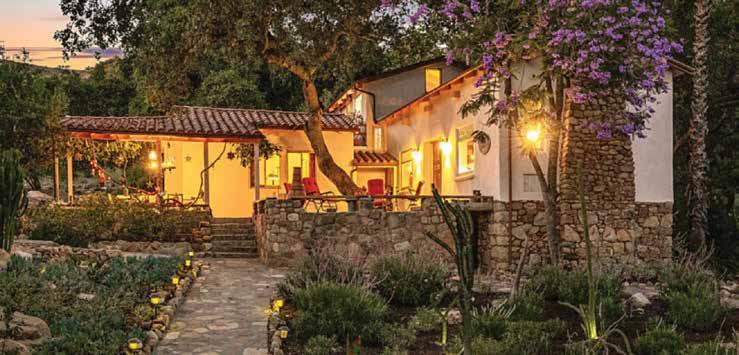
$1,425,000 FOR SALE




Live the Ojai Lifestyle in this lovely, modern family home. You will love entertaining in this spacious, lightfilled home. This three-bedroom, two-bathroom home has been tastefully updated with elegant finishes. You will enjoy the living room with a large fireplace and bright windows. The kitchen is open to the dining area and has quartz countertops and top of the line appliances for every cook’s dream. Curl up with your favorite book in the den which has french doors leading to one of many private outdoor patios with unobstructed views of the Topa Topa Mountains. There is a detached studio with many possibilities such as a gym, office or kids playhouse. Charming nooks and outdoor spaces turn this home into private little gem.

www.donnasallen.com donna4remax@aol.com



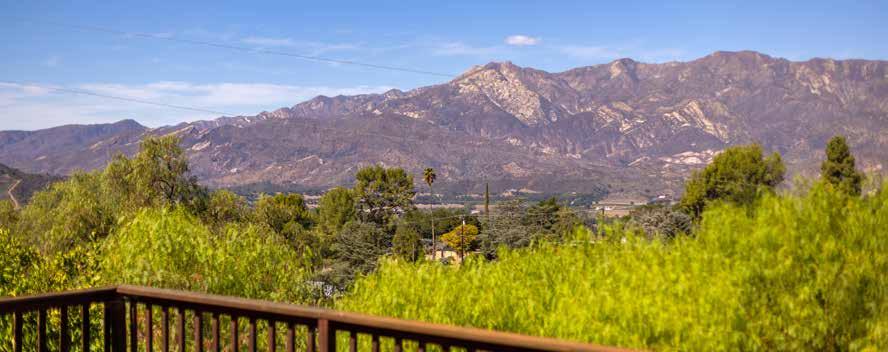


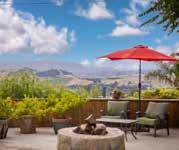






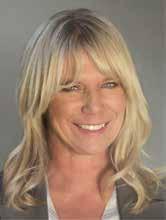














a n y m o r e . B u t n o w w e d i s c o v e r e d t h e m a g i c a l t o w n o f O j a i a n d t h o u g h t t h a t t h i s w o u l d b e t h e p e r f e c t p l a c e f o r T h e I v y t o r e - o p e n . O u r w i d e r a n g e o f i t e m s i n c l u d e s a n t i q u e s , n e e s t a t e j e w e l r y, s t e r l i n g s i l v e r, E u r o p e a n p o r c e l a i n s a n d p o t t e r y, l i n e n s , a n d e x c e p t i o n a l a n t i q u e f u r n i t u r e f r o m a r o u n d t h e w o r l d . A s a l w a y s a t T h e I v y, t a b l e t o p a c c e s s o r i e s a b o u n d i n n e d i s h w a r e , c r y s t a l , a n d s i l v e r t o n i s h o ff y o u r t a b l e i n s t y l e . C o m e s e e o u r n e w l y e x p a n d e d s h o w r o o m f e a t u r i n g e x c l u s i v e , v e r y m o d e r n , a n d u n u s u a l f u r n i t u r e , a r t , r u g s , a n d a c c e s s o r i e s . I f y o u n e e d t o n d t h e e l u s i v e " p e r f e c t " g i f t , T h e I v y i n O j a i i s t h e o n e - s t o p - s h o p f o r a l l y o u r n e e d s C o m e j o i n u s , a f t e r a l l : ' E v e r y o n e s h o p s a t T h e I v y.'


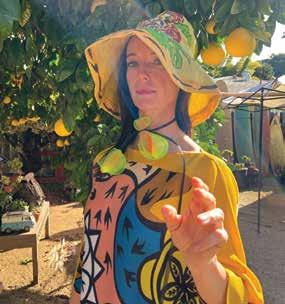










At Crescent Moon Collective, we embrace the essence of empowerment and sustainability. Our Ojai-based ladies boutique is a haven for those who seek clothing, shoes, accessories, and home goods that reflect their values and style. Rooted in the spirit of supporting small, female-owned businesses, we curate a collection that shines a spotlight on sustainable brands. We’re dedicated to nurturing a community of conscious consumers who believe in making choices that resonate with both their individuality and the planet. Step into a world where every purchase tells a story of empowerment, creativity, and a commitment to a better tomorrow




OPEN THURSDAY TO SUNDAY 12 - 5 PM
305 E Matilija Unit 101B Ojai , CA






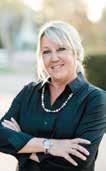

Welcome to your private sanctuary located in Rancho Matilija, an exclusive gated community nestled in the enchanted Ojai Valley (Shangri-La). Minutes from Lake Casitas and downtown Ojai. This gorgeous estate is situated on 2.99 acres, with beautiful 200 + year old Oak trees, and many fruit trees. The backyard of this estate is an oasis of tranquility, with a pool, spa and an older tennis court which presents opportunities for active pursuits. There are numerous patios for outdoor seating that invite you to indulge in moments of serenity. The large backyard presents options for expansion, providing the freedom to create a personalized outdoor haven (perfect for rejuvenation and relaxation). As you enter the home, you will be in awe of the grand foyer with vaulted ceilings and chandelier to set the tone of this gem. This spacious 4,397 square foot, 4-bedroom, 4 and a half bathrooms that includes a dining room, formal living room, family room, gourmet kitchen, and lovely breakfast area that views the gorgeous grounds. Entertaining is easy with a full wet bar adjacent to the kitchen. This home is an Entertainer’s delight! The downstairs main bedroom is spacious and features a fireplace and walk-in closet. There are fireplaces located in the living room, family room and main bedroom. Each bedroom in this residence has its own ensuite, providing convenience for family members and guests. Car enthusiasts will appreciate the generous 1,600 square foot 5-car garage, including raised ceiling RV bay, accommodating all vehicles and storage needs. There is a secondary dwelling, which features a spacious office or studio, along with a bedroom and bathroom. This provides endless possibilities for a home office, guest suite, or creative sanctuary. Don’t miss this opportunity to own this incredible estate in the prestigious community of Rancho Matilija. Contact us today for a private tour of this beautiful property.
Price Upon Request

 Author Dr. Nomi Prins Puts
Author Dr. Nomi Prins Puts



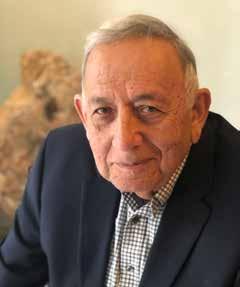
Story By Bret Bradigan
Story by Mark Lewis




Villanova is a Catholic, Augustinian Co-Ed and Boarding School serving students of all faiths in grades 6-12. In the Augustinian tradition, Villanova provides a well-rounded, challenging, values-based curriculum for all students that educates the mind, heart, and body.

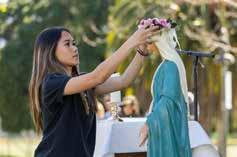

villanovamiddleschool.org | villanovaprep.org
First Day of Middle School: August 16, 2023
First Day of High School: August 17, 2023
For more information, please visit our website to learn more about our well-rounded programming that includes excellent opportunities in academics, athletics, arts, and service to the community.
To schedule a tour of our beautiful campus, please contact admissions@villanovaprep.org
UPCOMING EVENTS:
INFO NIGHT
Tuesday, Oct. 3, 2023
OPEN HOUSE
Sunday, Dec. 3, 2023
ARTISAN MADE CLOTHING & ACCESSORIES. EXCLUSIVE MUD LOTUS DESIGNS










Editor & Publisher
Bret Bradigan
Sales Manager
David Taylor
Director of Publications
Bret Bradigan
Creative Director Uta Ritke
Ojai Hub Administrator
Jessie Rose Ryan
Contributing Editors
Mark Lewis
Jerry Camarillo Dunn Jr.

Jesse Phelps
Columnists
Chuck Graham
Ilona Saari
Kit Stolz
Sami Zahringer
Circulation
Target Media Partners
CONTACT US: Editorial & Advertising, 805.798.0177
editor@ojaiquarterly.com
David@ojaiquarterly.com
The contents of the Ojai Quarterly may not be used, reproduced or transmitted in any form or by any means without the written consent of the publisher.
SUBSCRIPTIONS:
To subscribe to the OQ, visit ojaiquarterly.com or write to 1129 Maricopa Highway, B186 Ojai, CA 93023.
Subscriptions are $24.95 per year.
You can also e-mail us at editor@ojaiquarterly.com.
Please recycle this magazine when you are finished. © 2023 Bradigan Group LLC. All rights reserved.
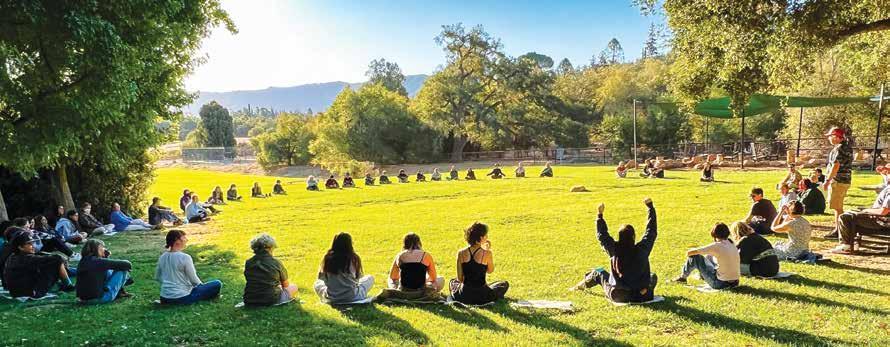










“It is better to be roughly right than precisely wrong.” — John
Maynard KeynesMuch of what people know about Ojai outside the orange curtain comes from the Ojai Studio Artists tour, Ojai Storytellers Festival and the Ojai Film Festival. We should all be proud to be represented by these organizations, especially their dedicated cadre of volunteers; they help make Ojai such an incredible place. It feels like Ojai is finally getting back to normal, or maybe even moving ahead to something better than normal.
John Maynard Keynes was one of the characters tossed up by circumstance as if tailor-made for the challenges of their age. For all the fluency of his erudition, deep observation and analytical genius, his theory of the economy basically boiled down to “animal spirits.” People get scared, they stop spending. Recession and Depression ensue. Then people get bored, so they start spending. A new cycle of growth begins.
This effect was dramatized starkly by the pandemic, when the economy shrank precipitously within days during March and April 2020. Between February and April, more than 20 million jobs were lost nationwide. Most relevant to Ojai, 3 million of those jobs were in leisure and hospitality — nearly half of all jobs in that sector. Listen to our Ojai podcast “Talk of the Town” interview with Chris Kandziora, chief operating officer of the Ojai Valley Inn, about how our largest employer coped with the personal devastation of the Covid-19 outbreak. In fact, many of those podcast episodes from the early months of the pandemic stand as an oral history of this period. Check them out and be reminded.
So it goes in Ojai. The local economy shows signs of life. Our “animal spirits” seem re-engaged. The Playhouse Theater makes visible daily progress. The work crews at the El Roblar Hotel line up for lunch at Ojai Tortilla House. The energy of the weekend scene is buoyant and festive. It’s been incredible to see how quickly the past three years have faded into the past. Hopefully, the positive lessons learned about mutual aid and camaraderie in those dark days will stay with us, even as the mist of dread vanishes.
We’re proud, as Ojai’s oldest and most prestigious magazine, to have weathered these storms with a greater sense of resolve and purpose. Each issue displays that spirit. Mark Lewis’ profile on the polymathic Richard Camp, for example, is about someone who has overcome obstacles, hearing loss in his case, to forge a successful return to theater. It’s a compelling and inspiring story. Dr. Nomi Prins came to Ojai to work on her most recent book, “Collusion,” and fell in love with Ojai and in particular with one of its more singular residents. With the heightened awareness of “Unidentifed Anamolous Phenomena” (formerly known as UFOs) because of startling congressional testimony from a military whistleblower, Ojai’s Robert Salas is back in the conversation talking about his own close encounter at a nuclear missile base 56 years ago. Chuck Graham brings back encouraging news that thanks to rains filling up Soda Lake, majestic sandhill cranes have returned to their usual migration route to neighboring Carrizo Plain. And canine-centric Ojai could surely benefit from Jerry Dunn’s informative, and funny, travel guide to Carmel, which shares a lot with Ojai besides our dogged love.
Ilona Saari’s childhood memories have been re-ignited thanks to David Cagnacci, familiar to many as the caterer for some of Ojai’s finest events, who shares her love for a drive-in burger. Since he’s taken over Summit Restaurant, the hilltop diner has regained its status as a destination for food-lovers. Then Sami Zahringer, who chronicles “Big Trouble in the Little Orange” with her astonishing verbal wizardry and revealing insights, gets at uncomfortable, and hilarious, truths about Ojai.
It’s going to be a busy few months ahead in Ojai. We hope that you find in this issue a reflection of the season and of ourselves.
BRANDI CROCKETT
is an Ojai pixie tangerine peelin’ native and an editorial and destination wedding photographer. Check out her work at fancyfreephotography. com
MARK LEWIS
is a writer and editor based in Ojai. He can be contacted at mark lewis1898@gmail.com.

JERRY DUNN
worked with the National Geographic Society for 35 years and has won three Lowell Thomas Awards, the “Oscars” of the field, from the Society of American Travel Writers.
UTA
is an independent artist, designer and curator. She is a member of Ojai Studio Artists and runs utaculemann.design.
CHUCK GRAHAM’S
work has appeared in Outdoor Photographer, Canoe & Kayak, Trail Runner, Men’s Journal, The Surfer’s Journal and Backpacker.
ILONA SAARI
is a writer who’s worked in TV/film, rock’n’roll and political press, and as an op-ed columnist, mystery novelist and consultant for HGTV. She blogs for food: mydinnerswithrichard. blogspot.com.



KIT STOLZ
is an award-winning journalist who has written for newspapers, magazines, literary journals, and online sites. He lives in Upper Ojai and blogs at achangeinthewind.com
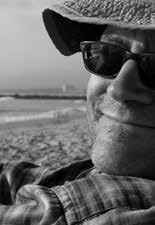
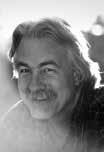


JESSE PHELPS
grew up in Ojai and has written extensively for and about the town. He enjoys freelance projects and throwing things. He can be reached at jessephelps@ outlook.com

SAMI ZAHRINGER
is an Ojai writer and award-winning breeder of domestic American long-haired children. She has more forcedmeat recipes than you.
Much of the origins of New Age spirituality can be traced back to, or at least through, Jiddhu Krishnamurti (1895-1986). He first moved to Ojai in 1922, and gave talks in our oak groves to hundreds of thousands of people. “Truth is a Pathless Land” is one of his most important essays, in which renounced his role as "World Leader."

Craig Walker, along with Mark Lewis, recently published a book, “The Dignity They Deserve,” about the remarkable Dr. Ethel Percy, founder of the American Association of Retired Persons, with nearly 40 million members, the world’s largest non-profit organization. It began in Ojai in 1957. A retired teacher, Walker is the son of famous architect Rodney Walker, and a lifelong student of Ojai’s history and culture. (Ep. 149)

Dennis Shives has been described as “the living embodiment of Ojai’s spirit,” known for his thoughtfully whimsical paintings, sculptures and larger-than-life barefoot presence. He talked about his influences growing up in Ojai, especially his artist grandmother, working with various media, including medal-winning sand sculptures and the changes he’s seen in his seven decades in Ojai. (Ep. 151)
Jeremy Cohen took over the baton at the Ojai Playwrights Conference this year from the legendary Bob Egan and hit the ground running with the prestigious play development workshop and readings. He talks about how he was always drawn to the stage and how theater brings insight and meaning to life. Ojai has long been known for bringing under-represented voices to the stage and he plans to continue that legacy.
(Ep. 154)

Peter Strauss made a name for himself as an actor in such classics as “The Jericho Mile” and “Rich Man, Poor Man,” and also as a master gardener. He took his Ojai property and turned it into a living laboratory for rare and endangered
ONE: Fresh off the staggering success of his 1997 film, “Titanic,” James Cameron was exploring the wreckage of the ill-fated ship for his 2003 documentary, “Ghosts of the Abyss.” He emerged from his submersible on Sept. 11, 2001 to learn of the World Trade Center terrorist attacks from his close friend, actor Bill Paxton, who was onboard the mother vessel. The video of this encounter, with Paxton’s measured explanation of the terrible tragedy, went viral in June 2023 after another Titanic-exploring sub went missing, and was found imploded near the wreckage.


plants. He talks about plantgathering trips to remote places in South America and the Namibian Desert in search of rare plants, the close community of horticulturists, and Ojai’s changing climate.
Strauss keeps busy with acting
projects, starring with JoBeth Williams in “Love Amid the Ruins,” at the Laguna Playhouse. He shared anecdotes of his many memorable encounters with film greats and his remarkable career. (Ep. 150)
2 of OJAI SEPARATION

TWO DEGREES BETWEEN
Paxton, a long-time Ojai resident, died unexpectedly in 2017 at the age of 61 from complications during a routine surgery. His friend, Mark Frost, co-creator of “Twin Peaks,” wrote a moving tribute to Paxton as the cover story of the Spring 2017 issue of the OQ Well known around town for his amiable, down-to-earth nature, Paxton left behind a rich legacy of film roles, including “Aliens,” “Twister” and “Tombstone.” He was nominated for three Emmys as the lead in “Big Love.” (Ojai’s first connection to the Titanic was Beatrice Wood, Cameron’s inspiration for the role of Rose.)


ONJuly 26 Dave Grusch, a former U.S. Air Force intelligence officer, was the star witness in the House Oversight and Accountability Subcommittee on National Security, claiming that he learned of a secret program to reverse-engineer alien spacecraft and a government plan to silence whistleblowers such as himself through what he called “administrative terrorism.”
Coming on the heels of the 2019 New York Times interview of Navy pilots about their confrontations with “unidentified aerial phenomenon” and bi-partisan requests this year for investigations from both the Senate and House of Representatives, curiosity about “what’s out there” may have reached a critical mass.
For Ojai resident Bob Salas, this turn of events is vindicating and long overdue. He especially found the testimony of retired Navy Commander David Fraver compelling.
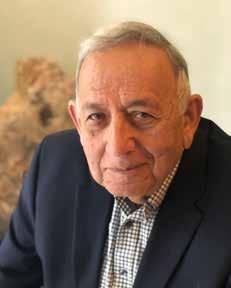
While piloting a F-18 jet off the coast of San Diego in November 2004, Fraver described an encounter with a “small, Tic Tac-shaped object … moving very abruptly.” The object had reportedly been observed for two weeks by air controllers on the aircraft carrier USS Nimitz, descending nearly instantaneously from 80,000 feet to 20,000 feet, hovering for hours, then ascending straight back up. Fraver told the committee that the incident had never been investigated, despite multiple eyewitnesses and a 90-second video that was taken by another crew after Fraver returned to the ship. “The Tic Tac object we engaged in November 2004 was far superior to anything that we had at the time, have today, or are looking to develop in the next 10+ years … What concerns me is that there is no oversight from our elected officials.”
on the morning of March 24, 1967 when he experienced one of the more significant encounters. Salas, author of “Faded Giants,” and “Unidentified: The UFO Phenomenon,” was working a 24-hour shift in a concrete bunker 60 feet below ground, which controlled 10 nuclear-armed intercontinental ballistic missiles. The security guard aboveground called, describing various unidentified flying objects around the base. He called back “five, ten minutes later,” saying that a red-orange object was hovering above the facility’s gate. “He was screaming in the phone, terrified … I told him to secure the facility at all costs,” Salas said.
It wasn’t long after that Salas noted the center’s indicator lights began going from green to red. The missiles’ guidance and control systems were shut down, and all ten missiles were rendered useless. Somehow, a signal had been sent through 60 feet of earth and hardened concrete, able to penetrate each system separately within seconds.
“I was feeling we were under attack,” he said. “It was a tense moment. We just didn’t know what the hell was going on. After we saw the missiles go down — the two launch facilities, where the missiles actually located, a mile or two away from us, the incursion lights were indicating someone was trying to get into our facilities.”
Salas said, “We sent guards to check it out, they said the same ob-
jects were hovering above the two facilities. They then lost contact with the security guard via VHF radio.” The tense moments passed when the guards said the objects vanished.

Despite hundreds of incidents being investigated by the government, and only a small percentage being ruled out, others believe that there are mundane explanations for these sightings — weather balloons or atmospheric phenomenon such as ball lightning, sun dogs or lenticular clouds. Rep. Mike Turner, chair of the House Intelligence Committee, said “There’s no evidence of this (Grusch’s testimony) and certainly it would be quite a conspiracy for this to be maintained, especially at this level.”
That was the first thought for Salas as well, a first lieutenant at this time — deep into the Cold War. Perhaps it was previously unknown Soviet technology, but “it would have had to send ten individual signals to the missiles through the bunker beneath 60 feet of earth and hardened concrete, and there was just no way that was possible. We don’t have anything that could do that.”
The aftermath of the event was nearly as bizarre. Salas learned from the local newspaper of a civilian experiencing a similar UFO incident very close by, and then 27 years later, learning that on March 16, 1967, eight days earlier from his own incident, another missile site at Malmstrom had shut down. Then he later learned of yet
another missile site shutdown happened at nearby Minot Air Force Base about six months earlier. “We lost 30 nuclear missiles within six months,” he said.
Salas was summoned soon after for a meeting with his squadron commander and a special investigations officer. He was told the incident didn’t involve any kind of Air Force exercise. Then he was asked to sign a non-disclosure agreement. “I didn’t even tell my wife,” he said.
In 1969, the Air Force released the Condon Report, which investigated hundreds of UFO sightings over decades and while it acknowledged valid eyewitness accounts, it recommended that Project Blue Book, opened in 1952, be closed. The Condon Report, Salas said, gave the Air Force cover to dismiss further sightings as unrelated to national security.

As the years went on, Salas began hearing about other incidents, with consistent details about the size and shape of the craft and their proximity to nuclear facilities. “There’s a long history with UFOs with nuclear facilities,” he said, and not just in the United States. “The Soviet Union experienced it in 1982 when a UFO came over missile launch facility. They were unnerved when it started the missile launch sequence. They could see it happening it on their equipment, and were powerless to do anything about it.”

The secrecy has been impenetrable. In the late 1990s, Salas noted that the Deputy Director of the Defense Intelligence Agency, Rear Admiral Thomas Wilson, was stonewalled when asking for information about private contractors and UFOs. Admiral Wilson, though, later denied having pursued these requests.
Salas himself claimed to have had “attempts to recruit me into this cabal. The people who have had these incidents, especially in the military, this is one way of controlling them.” He is convinced that this cabal is international, highly sophisticated and well funded, and has been around at least since the 1947 Roswell Incident.
Salas, who grew up poor in east Los Angeles, was admitted to the U.S. Air Force Academy in Colorado Springs upon the recommendation of his congressman, Chet Holifield, who gave him opportunity to compete for a slot, including rigorous mental and physical testing. “I won,” he said. Intending to become a pilot, Salas was steered instead toward the missile systems because of his math skills.
Struck by the knowledge that the Vietnam War “was going sidewise,” Salas retired his commission in 1971 and went to work for the National Aeronautics Administration. Then after retiring from the NAA, he “decided to become a school teacher.” In 1994, while perusing a bookstore’s shelves, he came across the title “Above Top Secret” by Timothy Good. “I was curious, on page 301, there was the only paragraph in the book to talk about UFOs shutting down missiles in 1967,” Salas said. “I jumped up and realized they must have declassified this thing. I got ahold of someone at MUFON (Mutual UFO Network) to file Freedom of Information Act requests, and so they did. They sent me documents about the Echo Flight incident (with which Salas was involved). Everything lined up … I had deliberately tried to forget because if I talked I could have spent time in Leavenworth.”
When he realized he was no longer bound by secrecy, Salas became himself a prominent UFO researcher, immersed in the study of past sightings, government documents, and eyewitness accounts. Salas delved into the declassified archives, meticulously piecing together evidence from historical incidents while using his own experience to inform his research. He learned of the other nuclear missile incidents in 1966 and 1967. UFO enthusiasts may remember him from appearances with the legendary Art Bell of the late-night radio show, “Coast to Coast.” Salas has spoken about his experiences in 15 countries, advocating for disclosure.
Thanks to Salas, among others, this push for transparency might be working. The All-Domain Anomaly Resolution Office was created in 2022 and tasked with investigating UAP incidents. In 2021, the Pentagon UFO Report was unable to identify 143 of 144 objects spotted between 2004 and 2021 and called for more resources, which led to the AARO’s founding.

Salas said AARO has big challenges. “I talk about the cabal … there’s been cooperation on information with not only Russia but all over the world.
“Congress is after the truth and is going to pursue it,” he said. “I’m optimistic we will get closer and closer. All agencies have to declassify, on any UFO subject, to AARO among other agencies. They have been hiding a lot of secrets, including things that could be illegal. I’ve been working hard to inform this research.”
Salas believes that a better-informed society could engage in more constructive conversations about UAPs, dispelling misconceptions and avoiding unnecessary hysteria. Salas actively participates in public lectures, seminars, and interviews.
For more from Salas, check out Episode 154 of Ojai’s podcast: Talk of the Town. Or point your browser to his website, SpiralGalaxy.org








The trillions of dollars of the Covid-19 pandemic bailout, intended to rescue Main Street from financial ruin, has instead magnified the disparities between Wall Street’s gains and Main Street’s struggles. It’s an issue that resonates from the glass towers of Wall Street to Ojai’s neighborhood retailers, restaurants and service workers.
Few people are better prepared to analyze this situation than Dr. Nomi Prins, author and commentator. Called “a traitor to her class,” the Ojai resident is a former Goldman Sachs executive. From her view inside the lion’s den, she has created a distinguished career calling out the hypocrisies of the high priests of finance at the juncture of money and politics.
If you need further verification that she is among the most influential financial commentators in the country, Senator Bernie Sanders, presidential contender and scourge of Wall Street, interviewed her
Prins said, “ They were fans of my book and fans of Bernie Sanders. Somehow the stars aligned and we connected though my publicist and his chief of staff. So not only did I have the opportunity to meet Bernie and establish what has become a lasting relationship.” At Sanders’ request, she served on his Federal Reserve Advisory Committee and appeared in front of the Senate Budget Committee in 2022.
If there’s a theme to her work, it’s how bankers have figured out over the past 12 decades to collectivize the risks and keep the profits.
Her most recent book, “Permanent Distortion,” which came out in 2022, explains in her trademark clear prose how the $5 trillion cash infusion in the earliest days of the Covid-19 pandemic has distorted the economy in ways that increase inequality. Of that cash, only a small portion went to the $1,400 checks to people, while the banks kept the rest on their books, which boosts their bottom lines rather than that money circulating into the real economy. Most of the eventual $8.5 trillion remains with Wall Street through their relationships with the Fed.

Dr. Prins said, “And that’s because of this permanent distortion that there’s inequality between the real economy and what goes into in the financial markets.”
She expressed concern over how much of this bailout money was retained by Wall Street firms, with little intention of deploying it to support the small businesses that form the foundation of local communities and job creation. “The bailout money was meant to resuscitate Main Street, to keep the engine of our economy running,” she said.
“Some money did indeed go to stimulus checks for individuals. Some went to companies. Most of it, I believe, wound up on the Federal Reserve’s books. The Fed’s books grew from $4.1 trillion be-
fore Covid to nearly $9 trillion after Covid. What that means is that the Fed effectively “printed” or created money electronically and used it to buy U.S. Treasury bonds ... If you do the math, it’s clear that a lot of those bonds wound on the Fed’s books ... the money the Fed printed for those bonds went to the banking and financial system.”
She says that many commentators blame rising inflation on those $1,400 stimulus checks, while ignoring more salient factors. “We’ve got an invasion of Ukraine by Russia. We’ve got sanctions and oil. We have energy problems, we have grid problems, we have food shortage problems and we have a very high level of rents and house prices at the same time. All those things together do, in fact, cause inflation,” she said.
Throughout the podcast, Dr. Prins expressed concern about how the global financial system has exacerbated inequality. She highlighted how the concentration of wealth in the hands of a few can lead to social unrest, political instability and a breakdown of trust in established institutions. Her analysis underscored the urgency for policymakers and leaders to address these disparities to ensure a more sustainable economic future for all.
“Civil unrest is only going to get worse, and the inequality was already happening before 2019, the year of the single biggest
number of civil uprisings around the entire world,” she said.
Not just Main Street businesses have struggled through the pandemic as the trillions of dollars the Federal Reserve has printed failed to “trickle down.”
She said the failure this summer of mid-tier banks such as First Republic or Silicon Valley Bank is because “they don’t get that kind of help from the Fed whenever they feel like it, as does JP Morgan Chase, Wells Fargo and Bank of America (which are at the) spigot. Those mid-tier banks, much closer to the consumer, were caught short by the Fed’s aggressive interest-rate increases, designed to throttle inflation.
“So when rates go up, the value of treasury bonds go down … all these mid-tier banks had to sell (treasury notes) quickly at losses in order to stop bank runs,” she said.
And in the perverse logic of Wall Street, it was rumors about these banks’ liquidity that caused the runs in the first place. “It all smacked of insider to me. Some tweets went out, the people that are closest to the bank are like, ‘Oh, we can manipulate prices here. Let’s cause a run. Let’s scare some people and see what shakes out.’”
This fear-based banking system, as Dr. Prins spells out in her book, “All the Presidents’ Bankers,” was born out of the panic of 1907, when
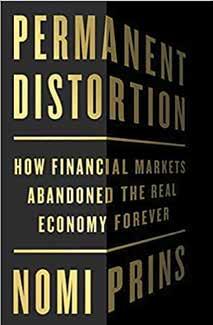
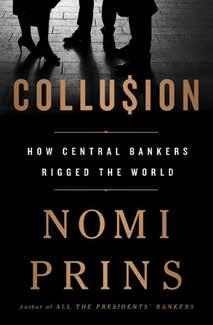

J.P. Morgan had to pledge much of his personal fortune, and to convince many of his peers to do likewise, to prop up the banking system after a series of bank runs threatened the whole apparatus. He organized meetings at his Jekyll Island, Georgia retreat, from which was born the Federal Reserve Act of 1913.
Dr. Prins said, “It’s often times the most innocuous looking, yet potentially dangerous acts, pass under Democrats (e.g. repeal of the Glass-Steagal Act in 1999, which was passed in 1933 as part of Franklin Delano Roosevelt’s New Deal reforms. The act kept retail and investment banking separate) and don’t pass under Republicans. I think the reason it passed under Woodrow Wilson was because it didn’t have as much support under Taft and so they rejiggered it to make it seem as if the Fed was really just like a mother bank to the farmers’ banks throughout the middle of the country. Obviously that’s not what happened, but that narrative still holds in Congress.”
As with recent inflation being blamed on stimulus checks to American citizens, so was the banking crisis of 2007-08 being blamed on people taking on mortgages beyond their means, and not the banks which devised and contrived these mortgages to begin with.
“If you thought of people as being ants and then thought of an elephant stepping on the ants to be like JP Morgan, so the ants might be smushed beneath them and create messiness on the pavement. But the reality is that the elephants ultimately have taken over the problems in the financial system and expanded upon them … they could hide the debts, could lie about debts, they could cut them and get rid of them. They could sell them off to, for example, a Norwegian municipality. There were all sorts of things happening in the world, only a tiny bit of which was the subprime mortgages that are blamed for the entire catastrophe,” Dr. Prins said.
“It was never going to work out even if every single subprime borrower made good on every single one of their loans. There would still have been a collapse of all the securities that were built on even if every single check cleared.”
Dr. Prins was born and raised in Poughkeepsie, New York, where her father taught mathematics at the local college. She followed him into math, graduating with her bachelor’s degree in mathematics from State University of New York at Purchase with a minor in music. She received a Master in Science in statistics from New York University, then her Ph.D in International Strategic Studies with a specialization in International Political Economy from the Federal University of Rio Grande do Sul in Porto Alegre, Brazil.
She took her math background to Chase Manhattan Bank, where she worked as an analyst, on to Bears Stearns office in London as a senior analyst manager, then back to Lehman Brothers as a managing director. It became clear that the system was rigged and she found a moral clarity in exposing it through writing about her experiences in “in the belly of the beast.”
Besides “Permanent Distortion,” she has written “Collusion: How the Central Bankers Rigged the World in 2018, “All the Presidents’ Bankers: The Hidden Alliances that Drive American Power” in 2014, which details the cozy, intergenerational and often interchangeable relationships between Wall Street and the White House. “It Takes a Pillage: Behind the Bonuses, Bailouts & Backroom Deals from Washington to Wall Street” was written in 2009, and “Other People’s Money: The Corporate Mugging of America” in 2006, and her historical novel, “Black Tuesday” was written about the Crash of 1929.
“The first book I wrote was ‘Other People’s Money.’ It came out in late 2004. At the time, I was one of the very few insiders or whistleblowers. The point was to explain what had actually gone on inside of the banking system with respect to the major scandals we saw in the early 2000s, Those included Enron, and other energy sector scandals, and WorldCom, and other scandals in the communications and tech space. The idea was to unveil how Wall Street abetted that process, and to show, and as it turned out, to predict, how unstable the banking system really was.”
It cost her a few of her prior relationships in the banking world, in a “You’ll never work in this town again” moment. “In terms of fallout, well, there are still many bankers that won’t talk to me And one time, there was a meeting called by the senior partners where the topic was not to speak to me,” she said.

She sought out Ojai as a writer’s retreat to work on “Permanent Distortion.”

“I had just returned from a few months in Brazil and China doing research for it. And I was very behind in putting that research to prose for my publisher. So I dropped everything I was doing in Los Angeles, take my two dogs, Homer and Charley, rent a place in Ojai for the month of August 2016, and do nothing but write up those chapters.
But because I had to walk my dogs — and I like wine and music, I asked the Soule park dog-owner crew for their suggestion of a good place to grab a glass of wine and hear some music. They all highly recommended “anything Nigel owns.” Nigel, being of course, Nigel Chisholm, then owner of The Vine. “So that’s where I went. But that Tuesday night, there was no music — there was trivia. So I stayed for a glass of wine and trivia. I met Nigel and he put me on Mayor Johnny Johnson’s team.
“Two weeks later, I returned to the Vine, mission completed on my chapters,” she said. “It was my last night in Ojai before I was set to return to Los Angeles and my LA life. That night Nigel put me on his team because they had a space. And we struck up more of a conversation. I was impressed with his stellar knowledge about the Nixon administration. And we had fun talking.
And — he was pretty cute. At the end of trivia, he rounded up some friends to go shoot pool at the Hub and asked me if I wanted to go. As it turned out, that Hub part was a ruse to keep our conversation going. Fast forward ... Nigel’s wine is doing so well that he’s opened up a Tasting Room in town for Feros Ferio Wine. And we are very happily married.”
Wall Street can seem monolithic and induce learned helplessness, but Dr. Prins encourages listeners to recognize the power of individual action, to make informed choices and support businesses and policies that align with their values. By being conscious and active in their local communities, individuals can influence positive shifts in the global economic landscape.
There’s a lot at stake. Dr. Prins argued that Wall Street firms have placed short-term profits above the greater economic good. ”It’s essential to understand that when Wall Street hoards bailout funds, they are essentially siphoning off resources from local communities, which depend on small businesses to thrive. This disparity in resource allocation further deepens the divides and hampers growth.”
Additionally, Dr. Prins said structural reforms are vital to address the root causes of this issue. “We need to reevaluate the relationship between Wall Street and the real economy. This includes tightening regulations, addressing corporate loopholes, and fostering an environment where financial institutions genuinely contribute to economic growth,” Dr. Prins advocated.










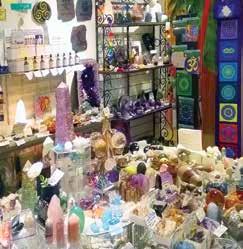







a young man, Richard Camp set out to be a stage actor. Instead, he got diverted into television, where he forged an Emmy-winning career as a writer, director and producer. When eventually he retired to Ojai, he returned to his roots by getting involved in local theater, mostly in behind-the-scenes roles. And now, at long last, he is preparing to return to the stage in a big way as a performer, with a semi-autobiographical one-man show called “Lordy Mercy.”

Richard Camp welcomed the Ojai Art Center Theater audience to opening night of “Bless Your Heart.” Then, as the house lights dimmed, he took his designated aisle seat in Row F next to his wife, Ilona Joy Saari. The date was Sept. 6, 2019, and all the theater’s 125 seats were occupied, some of them by old friends of Richard’s who had driven up from L.A. for the play’s world premiere.
The protagonist, loosely based on Richard himself, was a highly educated man of science struggling to come to terms with his mother’s fervent Christian fundamentalism. Richard had been tinkering with two different versions of “Bless Your Heart” for some 20 years. Now, finally, he judged the play ready for prime time. But it still felt weird to bare his fraught family history for the entertainment of strangers.
new stepfather moved the family to Madison Heights, Mich., a blue-collar suburb of Detroit.
Richard’s stepfather was a mechanic, a truck driver, a fire-andbrimstone fundamentalist preacher, and a grade-school dropout who saw little value in formal education. He urged Richard to follow his example by dropping out and getting a job. But Richard did not see his stepfather as anyone to emulate. He stayed in school and ended up as class valedictorian.
person
my family
school.
It was there at Madison High School that Richard first caught
Beyond these concerns, another question lingered. How would the audience react? They would be the ultimate arbiters of the play’s success or failure.
“Opening night was fraught with emotions as the dialogue in my head shifted from how I felt to how the audiences might feel,” he said. “Ultimately, it became a matter of ‘Let it go.’ Trust the exquisitely talented cast to perform, come hell or high water, and let my life come to life.”
came to life in Gastonia, N.C., where he was born on Dec. 16, 1946. His father abandoned the family early on, and eventually a

“Watching a play that you’ve written, about a family dynamic that can be described as ‘I survived,’ was as close to an out of body experience as I’ve ever encountered,” he said in a recent interview. “Was I fair to my mother? Fair to my brothers? Fair to myself? Did I reveal secrets that would be better left alone?”
“I was the first
in
to graduate from high school,” he said. “I absolutely loved
Education was a liberating force for me.”RICHARD CAMP STARTING OUT
the theater bug, after being cast in a small role in “A Midsummer Night’s Dream.” He went on to play the lead role in the school’s production of “The Mouse That Roared.” But at the time he had no thought of going on to study acting in college. In fact, he did not think he could afford to go to college at all. But one of his teachers urged him to apply to Rollins College in Winter Park, Fla., where she thought financial aid would be available. As it turned out, Richard not only was accepted by Rollins, but also by Princeton and the University of Michigan. He couldn’t afford Princeton, which left his choice between Michigan and Rollins.
“I had to get away from home, and Michigan was 45 minutes away and Florida was 45 hours away, so I chose Door No. 2.”
He started out at Rollins as an English major, but soon gravitated to the theater department and was cast in Chekhov’s “Uncle Vanya.”
Soon he was starring as Fagin in “Oliver!” By now Richard was
majoring in drama as well as English, which meant he had to direct a play for his senior thesis. This being 1969, he chose “Hair: The American Tribal Love-Rock Musical,” which he recently had seen on Broadway.
He not only directed it, but he also played Claude, one of the leads. During rehearsals, Richard found himself singing off-key, which led to an alarming discovery: He was losing his hearing in one ear. But the show was a success, so Richard shrugged off the hearing issue and headed to New York to make it as an actor.
immediately put his name in lights, so Richard tried his hand at music with a folk-pop group called Summershine, composed of Rollins students and former students.
“We covered some Simon and Garfunkel, some Carpenters, some John Denver,” he said. “And I wrote several original songs for the group and sang lead on them.”
Summershine did a six-week tour of Europe in the summer of
1970. Upon their return, they performed in Washington, D.C., at a party hosted by a lobbyist who was the father of someone in the group. In the audience that day was Melvin Laird, President Nixon’s secretary of defense. This being the height of the anti-war movement, Richard took the opportunity to tweak Laird by playing the Phil Ochs protest song “Draft Dodger Rag.”
“I sang it directly to him,” Richard said. “He responded by flashing a peace sign afterward. My little contribution to ending the Vietnam War.”
Pivoting back to acting, Richard returned to New York in 1971 to give theater another shot. He honed his skills by joining a series of summer-stock companies in Castleton, Vt., Jackson Hole, Wyo., and Vallejo, Calif.

“But the hearing issue was still something I had to deal with,” he said.
Richard was a writer as well as an actor, so he eventually allowed himself to be diverted from acting for the stage to writing for television, where his hearing problem was not an issue.

His long and remarkably varied TV career ranged from writing news stories for ABC’s “World News Tonight” anchors such as Barbara Walters and Frank Reynolds, to co-producing the first season of the reality show “Big Brother,” to producing “Extreme Cuisine” for the Food Network, to writing “50th Anniversary of the Bikini” for the USA Network, to producingdaily reenactments of the O.J. Simpson civil trial for “E! Entertainment Television,” to serving as head writer for ABC’s “The Home Show.” Along the way, he was nominated three times for an Emmy, winning in 1980 as a writer for NBC’s “Hot Hero Sandwich,” which he described as “Saturday Night Live” for teenagers.
At first, Richard did not let his TV jobs completely displace his interest in the theater. He wrote a play called “Cuckoo Birds” that ran briefly at the Vortex, an off-off-Broadway theater; then in 1984 he was one of the writers who worked on “Diamonds,” a musical revue about baseball directed by the legendary Harold Prince. It ran for 104 performances at the prestigious off-Broadway Circle in the Square Theatre.
“It opened on my birthday in December 1984, and closed before baseball’s Opening Day the following spring,” Richard quipped.
Another of Richard’s 1980s projects has enjoyed a much longer run: His marriage to the writer Ilona Joy Saari. They met cute in 1978 while he was head writer for “People,” a TV version of People Magazine. He had written a segment about Greta Garbo which impressed Ilona, and she was looking for a writing partner, so she visited the show’s offices to meet the author.
“She announced, ‘I want to meet the woman who wrote the Garbo piece,’” Richard recalled with a smile.
He introduced himself to her, pointed out that he was in fact a man, and asked her for a date. They became writing partners first, then fell in love and got married. They were preparing to celebrate their 40th anniversary on September 24 as this issue of the Ojai Quarterly went to press.

Ilona is a former rock ‘n’ roll writer, speechwriter, political press secretary, TV and film writer and newspaper essayist. Currently she’s a food blogger, a Huffington Post contributor, an Ojai Quarterly columnist and a mystery novelist. She and Richard moved from New York to Southern California in 1985 and have been here ever since.
They had hoped to start a family, and even though those hopes never came to pass, they did acquire an “unofficial surrogate daughter” due to Ilona’s work tutoring underprivileged children at an L.A. elementary school.
“We both fell in love with one of her students, Alma Hueso, better known as Gaby,” Richard said. “We took her to museums and restaurants and the theater, opening up a wide variety of experiences for her. Ilona taught her to swim, and Ilona’s mom became Gaby’s surrogate grandmother. I was the second person to dance with her at her quinceanera, and when she later married, the ceremony was held at our house, where she asked me to walk her down the aisle. Heartwarming moments, indeed. She is now a successful photographer living in Minnesota.”
TV jobs were plentiful in Hollywood, which kept Richard busy
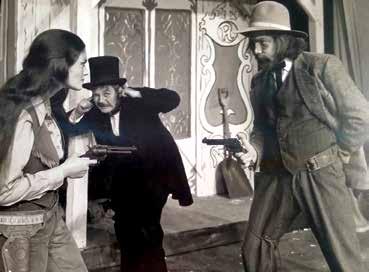
but left him little time for writing plays.
“So I was away from [the theater] for quite a long time, and I really missed it. But TV was paying the bills, so …” Eventually, he started writing plays again, when he could snatch enough
time away from his various TV day jobs. “Credo,” starring Jean Smart, was staged at the Odyssey Theatre in West L.A. “Waiting for Garbo” was produced at the Colony Studio Theatre. He also wrote “All My Fathers,” his first attempt at an autobiographical play, and held a few readings of it.
“I was slowly getting back to the theater,” he said. “And then we came to Ojai, ostensibly to retire.”
had discovered Ojai while visiting their friends Stuart and Kyle Crowner. Richard and Ilona moved here from Studio City in 2013. As a TV retiree, Richard now had plenty of time to return to his first love, the theater. He had an entree to the local drama scene though Stuart, who was producing plays at the Art Center for Joan Kemper’s Ojai Performing Arts Theater. One of these was Shakespeare’s “Twelfth Night,” directed by Michael Addison, who cast Richard in a small role as a priest. He only had one line, but he was thrilled to be back on stage. It was the first time he had trod the boards in decades.
“I felt comfortable, accepted, as if I’d returned home again,” he said. “Full circle.”
By 2016, Richard had moved up to the director’s chair to helm Peter Shaffer’s farce “Black Comedy.” This play had a special meaning for Richard, who had seen it on a trip to New York in 1967 during his Rollins College days — the first Broadway show he ever took in. Later he acted in it at Rollins, in a production directed by Shaffer himself. Now he chose it as the vehicle for his Ojai directorial debut. It was a major success,
and by 2018, Richard had been named artistic director of the Art Center Theater.
His three-year run in that job featured a string of hits, many of which he directed himself. One he didn’t direct was his own “Bless Your Heart.” After moving to Ojai, Richard had dusted off that never-produced “All My Fathers” script and reworked it into a play that is mostly about his relationship with his mother, a poorly educated Christian fundamentalist played by Susan Kelejian. David Nelson Taylor played Thomas, the character loosely based on Richard himself.
Thomas, like Richard in real life, had been born into poverty and ignorance, and used education as his escape route. He wishes his mother had been able to do the same. She, mostly content with her lot, wishes that he would seek consolation in religion, as she does; or that at least he would respect the choices she made in life. To ensure a balanced presentation of these contending viewpoints, the secular agnostic Richard assigned the director’s chair to Tom Eubanks, an Art Center veteran who is an evangelical Christian.
And so we return to Richard sitting in that aisle seat in Row F on that Friday evening in September 2019, as the house lights go down. For the first time, an audience of (mostly) strangers would pass judgment on the play he had spun from the straw that comprised his own life.

“Would audiences react to a story about a poor Southern family with a protagonist who was lifted from the darkness of a stepfather’s stultifying religious absolutism by the healing power of education? I asked all those questions of myself as I wrote ... It was terrifying and uplifting at the same time.”
Then the play began. When it ended, the applause assured Richard that he had succeeded.
“The cheering and the standing ovation were more than I could possibly hope for,” he said. “And the remaining 11 standing ovations throughout the entire run made all the heartaches and hard work worth every minute of it.”
Richard’s late mother never had the opportunity to see the play or read the script, but he thinks she would have been touched by the audience’s response. He said she always supported his theatrical endeavors. When she came to see him perform in high school, she brought a script so she could follow along and make sure he got his lines right.
“One little point that was very touching to me,” he said. “At the closing performance of ‘Bless Your Heart,’ unknown to me beforehand and as a surprise to me, Susan Kelejian and the cast had asked J.B. White and other musicians to come on stage and sing ‘I’ll Fly Away,’ which was my mother’s favorite song, and which was sung at her funeral ... are you crying yet?”
These days Richard is artistic director at the Ojai Performing Arts Theater, which stages its productions at Matilija Auditorium. Their most recent show was “The Fantasticks.” If all goes as planned, OPAT’s 2024 line-up will include “Lordy Mercy,” a one-man show Richard fashioned from some of the same autobiographical material that underpins “Bless Your Heart.” He will play the part himself, marking his return to the stage in a major
role for the first time in almost 50 years.
Joan Kemper, calls “Lordy Mercy” “the funniest show I’ve never seen yet,” according to Richard, who expects that Joan (and others) will get to see him perform it on an Ojai stage sometime soon.


One obstacle in Richard’s way is a recent diagnosis of colorectal cancer. He has already completed radiation treatment and is currently undergoing chemotherapy, and his doctors assure him that things are going well for this highly treatable and often curable disease.
“I’m very confident with what my doctors tell me,” Richard said. “It’s my actor training in me — I listen to the director.”
He’s also confident that his performance won’t be hampered by his impaired hearing, which he has dealt with his entire life. Three years ago, during the pandemic, he decided to get a cochlear implant, which brought about a dramatic improvement.
“It’s a game changer. Remarkable. It bolsters my confidence greatly, in everyday life and in the theater, so I’m looking forward to taking the stage. And besides,” he added, “it’s a oneman show, so I don’t have to worry about dropping cues from other actors!”
Steeped in a rich foundation of over 45 years-experience, Kerry Mormann & Associates is the Gold Standard for Ranch and Lifestyle properties along the Central Coast of California. Our team encompasses decades of experience in not only real estate, but the highest level of hospitality, community relations, and environmental conservation.
2,862±AC | CARPINTERIA | $29,000,000
8 buildable lots ranging from 40-160 acres. Miles of hiking and horseback riding trails. Ag & Building envelopes in place. Panoramic ocean, island, and mountain views.
6,500AC | VENTURA | $27,650,000

Rolling hills, streams, and pastures. Currently used for cattle grazing. There are 18 legal parcels (17 Certificates of Compliance). Possible conservation tax benefits.

3,000±AC | SIMI VALLEY | $12,000,000

Wide-open land ideal for a large ranch, or multiple smaller ranches. Developed & natural springs. Trails connecting to Chumash Park, Rocky Peak, Chico Canyon, and others.

98±AC | LOS OLIVOS | $9,900,000
Represents the gateway to the Los Olivos & Foxen Canyon Wine Trails. Approved 20,000± SqFt winery development plan. Property has 23 acres currently planted, with 9 additional acres plantable.

Kerry Mormann & Associates | (805) 682-3242 Office

DRE #00598625 | info@coastalranch.com
coastalranch.com
October 7, 8, 9 2023 the 40th Annual Ojai Studio Artists Tour


10am - 5pm
One of California’s premier art eventswith painters, sculptors, jewelers, ceramicists, digital, glass, fiber, and woodworkers. Over 70 artists will be opening their studios across the Ojai Valley.


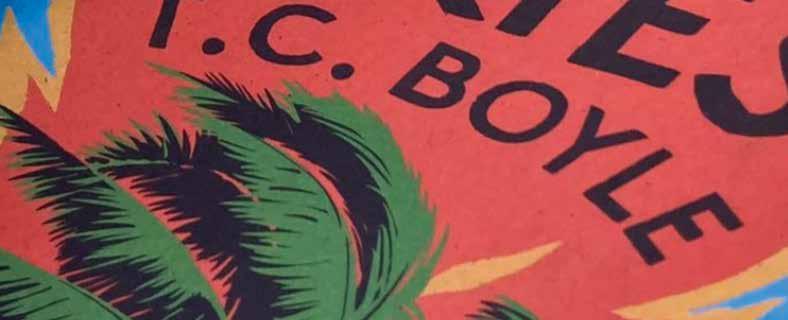


T.C. Boyle’s latest novel, “Blue Skies,” released this July, opens with a young woman named Cat, just arrived in Florida, and dreaming — we soon learn — of becoming an Instagram influencer. On a walk near the beach, she sees a sleek black snake in a tank in the window of a store.
Mesmerized, she imagines how it might look on her. Boyle writes:
They were like jewelry, living jewelry, and she could see herself wearing one wrapped around her shoulders to Bobo’s or the Cornerstone and sitting at a sidewalk table while people strolled by and pretended not to notice. It would make a statement, that was for sure.
Cat turns into the reptile store, called Herps, and soon finds herself chatting with the amateur herpetologist and owner, who quickly agrees to sell her the little black Burmese python she likes the look of, and for only $300. He does warn her — as does a trusted friend at her favorite bar — that Burmese pythons grow quite large, as long as 19 feet. They can be dangerous. She pays no attention. She’s confident that her fiance Todd — who doesn’t want to hear any talk of babies — will go along with her when she shows it off to him at home. How could he refuse her?
And so the Chekhovian gun is taken down from the wall and placed on the table and the story begins. The Burmese Python — soon to be known as Willie — goes on to quietly play his biological role to perfection, ruthlessly claiming its rightful place in Boyle’s pantheon of creatures, wild or confined, which quite often turn a Hobbesian red in tooth and claw.
“Do you like it in your stories when nature turns on mankind?”
I asked Boyle in an interview. “It’s been suggested by reviewers that that’s what ‘Blue Skies’ is about — the revenge of nature.”
“I avoid interpretive questions because my answer, taken as definitive, will destroy readers’ own interpretations,” Boyle answered. “That said, I do like this line of thought. ”
If you go back to the novel to which this is the companion piece, 2000s “A Friend of the Earth,” you will see that a certain rock star living on a ranch in Santa Ynez meets a grisly (and grimly hilarious) fate beneath the claws and incisors of one of his pet lions.”
It’s true, and it’s a fact that T.C. — aka Tom — Boyle has been fascinated with animal-human drama from the start of his career. (His first published story in the 1970s was a comic reimagining of the Lassie myth, called “Heart of a Champion.”) And
although he doesn’t always side with humanity, they consistently surprise. Again and again his stories pit animals against humans, and again and again they overturn the expectations of the humans who think they have the creatures controlled, extirpated, or even just plain understood.
Sometimes the animal surprise turns out to be a good one. Predictability is anathema for Boyle.
a story published in 1991, a middle-aged man is in love with a herpetologist preoccupied with the fate of the earth. He’s desperate for a little affection, because she’s obsessed with the end, and turned off by doomy thoughts. He goes with her to a scientific convention focused on snakes and frogs. A lecturer warns of an amphibian apocalypse. For years this lecturer has been searching for a certain California toad. It’s gone extinct, he says, and the speaker knows just what that means.
“...everywhere you look the frogs and toads are disappearing, extinction like a plague, the planet a poorer and shabbier place. And what is it? What have we done? Acid rain? The ozone layer? Some poison we haven’t yet named? Ladies and gentlemen, it’s the frogs today and tomorrow the biologists … before we know it the malls will stand empty, the freeways deserted, the creeks and ponds and marshes forever silent. We’re committing suicide! We’re doomed, can’t you see that?”
Our hero’s hopes are momentarily crushed, but desperate to act — for his libido as much as for the frogs — he soon takes his anxious girlfriend out into the wild world, determined to confront the facts together, whatever they may be. And for his determination they are rewarded — sexually. Surprisingly.
In Big Game, another animal-themed story from 1990s, a teenage cynic goes with her rich father and second wife to a shabby big game hunting preserve in the San Bernardino area, where her parents will go on a game-hunting safari. Besides gazelles and a couple of flea-bitten lions, the biggest star of the tacky “African Game Ranch” is an old elephant named Bessie Bee. The rich father pays $16,500 to shoot her, intending to have her stuffed and mounted
a trophy in his business lobby.
Boyle describes the climactic scene from Bessie’s point of view:
For her part, Bessie Bee was more than a little suspicious. Though her eyes were poor, the Jeep was something she could see, and she could smell the hominids half a mile away. She should have been matriarch of a fine wild herd of elephants at Amboseli or Tsavo or the great Bahi swamp, but she’s lived all her 52 years on this strange and unnatural continent, amid the stink and confusion of man. She’d been goaded, beaten, tethered, taught to dance and stand on one leg … and then there was this, a place that stank of the oily secrets of the earth, and another tether and more men. She heard the thunder of the guns and she smelled the blood in the air and she knew they were killing. She knew, too, that the Jeep was
there for her.
But although Boyle enjoys seeing the tables turned, and is quite certain humanity is doomed — it’s just a matter of a little time, he says — he’s unsentimen - tal about animals themselves. They may be exploited, abused, and even massacred (as are the feral pigs on Santa Cruz Island in “After the Killing’s Done,” a satirical reimagining of the recent history of Santa Cruz Island) but they’re nothing like the soft pillowy creatures of a Disney cartoon.

An example: this spring along the Central Coast, seals and sea lions in distress from poisoning by domoic acid from bacterial “red tides” often beached themselves on the sand, and even turned aggressive. Surfers waiting in the water for a wave reported being attacked, and even sometimes bitten. When Boyle heard this story, he asked: “Why

shouldn’t the seal take the surfboard from these interlopers in the ocean and catch a wave himself?” (Shades of internet darling Otter 841, who has been stealing surfboards and upending kayaks near Santa Cruz.)

But in the next breath, he admitted that he, too, is an interloper in the ocean, and has good reason for fear.
“Some years ago I was bodysurfing alone near San Francisco in some mighty frigid water and noticed that a seal was bodysurfing along with me,” Boyle commented. “I asked myself, ‘What do Great Whites eat?’ and then immediately got out of the water.”
For Boyle, it’s simple.
“If the story is compelling, you follow it,” he said in an interview. “As for Cat and her selfish and whimsical purchase, know that the invasive Burmese python decimating mammalian life in the Everglades got there precisely through actions such as hers.”
In 2015, Boyle’s publisher opened a Twitter account for him, and ever since Boyle has used it to post stories and news about book tours and readings — as he continues to write and publish an unending stream of short stories, somehow, astonishingly, even while publishing no less than 19 novels. But mostly he uses his account (@tcboyle) to post pictures from his life as a working writer, including early morning shots from his foggy street in Montecito, afternoon pictures from his walks to the beach with his Puli dog, and plenty of amusing one-line reactions to comments from fans.
From close-ups of the rats and mice Boyle catches in humane cages (to be later released in the hills, far from his elegant home), to coyote lairs, to seals and sea lions on the beach, to crows and seagulls watching from above, Boyle’s fascination with other species stands out. And he readily admits to enjoying their untamed and unruly ways. No matter what happens to the people who try to control them.

“As for the convention of good prevailing over evil, I want that to be so but at the same time want to avoid making a catechism of it,” Boyle said. “Take a look, for example, at what happens to the villain in my previous novel, ‘Talk to Me.’ When Sam, the prevailed-upon chimp in Moncrief’s experiments turned the tables, my heart soared. I created that world, and as God and creator, I can tip the scales any way I want.”
In the ironically-titled “Blue Skies,” Boyle throws one environmental disaster after another at a Santa Barbara family led by the idealistic mom Ottitle, a blunt father named Frank, and two very different grown siblings: Cat, a pretty young woman with little direction and a bit of a drinking problem, engaged to Todd, a liquor promoter, and Cooper, her brother, a frustrated entomologist. As the seas rise, threatening to swamp the condo Todd inherited on the beach in Florida, Cooper in Santa Barbara is bitten by a tiny tick, and the resulting infection — caught too late — costs him an arm. This embitters him all the more. Then at his sister’s wedding, an ex-girlfriend takes him aside and tries to seduce him. So what are you saying — you’re turned on by cripples?” he asks her, a little shocked, in the midst
of making out.
“Oh, stop it,” the ex-girlfriend says. “You know I’ve always had a thing for you.”
He’s surprised — and put off. We know Boyle’s characters through their flaws. Although not without courage — the mother in “Blue Skies” risks her life to race across the country to her pregnant daughter’s side amidst an incoming hurricane — more often in Boyle’s stories we see unimproved and struggling people. The shallowness in Cat, the bitterness in Cooper, the frustrated helplessness of Ottile, trying to do the right thing in a world that seems not to care — through their limits we understand these characters. As individuals, not heroes.
For Boyle, this can’t be helped. This, in fact, is the way it should be.
“I let my characters find their own way,” he said. “It’s all in the tone, of course, so that the most unworldly characters can be the most compelling (think of the title character of Nabokov’s hilarious and heartbreaking ‘Pnin,’ for example). Oblivious Cat, hectoring Cooper, and their environmentally-conscious, do-gooder mother, are all part of each of us.”
Climate chaos rules “Blue Skies”: with rising seas, a hurricane, a heat wave, a Bug Apocalypse, unexpected squalls that rip apart Cat’s wedding in California, a fire — even a rogue billionaire’s attempt to cool the planet by spreading sulfur dust in the upper atmosphere. Which seems to work, at first. Boyle likes exploring the consequences of climate change in fiction, but fervently refuses any hint of a “message.”

“At least from my point of view, art is not polemical, but rather it is a seduction, so that beginning with an axe to grind is inimical to it,” he said. “I would like to think that my art has wide appeal, but then the people who value that art and the ideas it conveys are the ones who least need convincing about the state we’re in, unlike, for instance, right-wing demagogues and their mindless followers.”
“Blue Skies” has found wide appeal: Boyle said to date it’s the second most popular of his books, behind his modern classic “Tortilla Curtain.” For Boyle, it’s just plain fun. He likes people,
he says, and he likes exploring their kinks and quirks in fiction — just as he likes interacting with fans on Twitter and at readings.
“From the beginning on Twitter, I have always posted photos, with comments,” he said. “What am I seeing at this moment? What world is this? Where am I now? People from around the globe respond and that is thrilling. We have built a respectful, joyful, and self-regulating community there. I have never viewed or posted on Twitter otherwise. What fun, huh? What thrilling and hilarious and insuperable fun.”








An international center dedicated to understanding, harmony, and peace among all peoples, comparative studies in religion, philosophy and science, altruism and the ideals of a spiritual life.


An inter national center dedicated to understanding, har mony, and peace among all peoples, comparative studies in religion, philosophy and science, altr uism and the ideals of a spir itual life





We must tr y to understand our own nature, that we may see the path which leads to the realization of the Self.

Perhaps it was potter and “the Mama of Dada” Beatrice Wood’s influence, going back nearly 90 years. Maybe it even goes back further, to the Chumash people’s ingenious and astounding artistry with basketry. It’s clear that Ojai has long been a haven for artists. The natural beauty
framed so well by the long arc and lush light of an east-west valley lends itself to artistic pursuits, as does the leisurely pace of life, the sturdy social fabric of a vibrant community and the abundant affection and respect for artists and their acts of creation.
Firestick Pottery provides classes, studio/kiln space and a gallery abundant with fine ceramics.

1804 East Ojai Avenue. Open from 10 am to 6 pm every day. Gallery
Open to the Public. FirestickPottery.com 805-272-8760
Featuring local artists, including William Prosser and Ted Campos.
American-made gifts and cards, crystals, and metaphysical goods.
304 North Montgomery nutmegsojaihouse.com 805-640-1656
OVA ARTS
40+ LOCAL artists with a unique selection of contemporary fine arts, jewelry and crafts.
238 East Ojai Ave 805-646-5682
Daily 10 am – 6 pm
OjaiValleyArtists.com
paintings & drawings
20th century & earlier
Thursday – Sunday noon – 5 p.m.
311 North Montgomery Street canvasandpaper.org



You haven’t seen Ojai until you visit us!
Local art of all types, unusual gifts, Ojai goods! Open daily 11 a.m. to 5 p.m. 323 Matilija Street
JOYCE HUNTINGTON
Intuitive, visionary artist, inspired by her dreams and meditations. It is “all about the Light.” Her work may be seen at Frameworks of Ojai, 236 West Ojai Ave, where she has her studio. 805-6403601
JoyceHuntingtonArt.com
KAREN
On a road trip to our new home in 1964, my children kept asking, “Are we there yet?” Our new town was integrating its schools. Reviewing these diverse faces in 2021, I ask myself, “Are we there yet?” KarenKLewis.com

CINDY PITOU
BURTON
Photojournalist and editorial photographer, specializing in portraits, western landscapes and travel. 805-646-6263
798-1026 cell OjaiStudioArtists.org
LISA SKYHEART

MARSHALL
Colorful watercolor+ink botanical paintings with birds, insects and joy. Open studio October 7,8,9.
Info: SkyheartArt.com or OjaiStudioArtists.org
Plein air landscapes, figures and portraits in oil by nationally-acclaimed artist Dan Schultz.
106 North Signal Street | 805-317-9634
DanSchultzFineArt.com

MARC WHITMAN
Original Landscape, Figure & Portrait Paintings in Oil. Ojai Design Center Gallery.


111 W Topa Topa Street. marc@whitman-architect. com. Open weekdays 8 a.m. to 5 p.m.

TOM HARDCASTLE
Rich oils and lush pastel paintings from Nationally awarded local artist. 805-895-9642



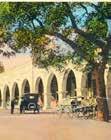
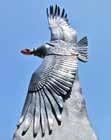




A uniquely curated kitchenware + pantry goods shop located in Ojai, CA
@blanchesylviakitchen


443 El Roblar, Meiners Oaks


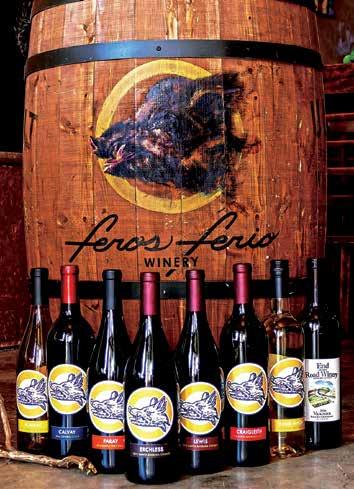
64 destination drive-in
Treasured American Experience Thrives at Summit Restaurant
By Ilona Saari64
64-65
food, beverages & more
Ojai’s Essential Restaurants, Products
 By Staff
By Staff
64-65
chef randy
Going Meat-Free for Fun & Health
By Randy Graham

Cagnacci, aka Private Chef Dave, was trained at the Scottsdale Culinary Institute and for 20-plus years, give or take a year or two, worked in restaurants and catered parties, large and small. But, like screenwriters who really want to direct, it was Chef Dave’s long-held desire to own a burger joint.
Before McDonald’s, et al, overpopulated the planet, burger diners, dives, drive-ins, shacks and stands, aka “burger joints,” dotted the American landscape. I was seven when I first fell in love with such a joint.

Vacationing in Massachusetts, my father drove our family to a popular outdoor burger stand for dinner. We all loved burgers, so I was shocked when I heard him order cheeseburgers. “What’s a cheeseburger?” I asked my mom (remember, this was before the McDonald’s blitzkrieg). Cheese on ground beef? But, when
I took that first glorious bite of that burger stuffed into a white bread bun, smothered with American cheese melting over its edges, a chorus of cheese-elujahs sang in my head. That moment was only enhanced as the sun set over the burger shack, as lightning bugs lit up the sky.

Over the years, I’ve often wondered what genius first melted a slice of cheese on a burger.
He or she should be in the culinary history books! I even went
to the big public libraries in Boston and New York but was never able to find that answer. Finally, Google came to my rescue…
To paraphrase: As the legend goes, in 1926, 16-year-old Lionel Sternberger (Really! What better name!) was flipping burgers at his father’s restaurant, the Rite Spot in Pasadena, California.
Bored, Lionel de-
cided to slap a slice of American cheese onto a sizzling burger frying on the grill. After a bite, his dad most likely heard the same heavenly chorus I did, as the “cheese hamburger” was soon on the menu. Others have laid claim to discovering

this food phenom, but it was a bored 16-year-old boy (aren’t all teenagers bored?!) who deserves the honor.
To paraphrase a famous quote from the classic movie western, “The Man Who Shot Liberty Valance”… “if you have to choose between fact or legend, print the legend.”
Dave Cagnacci was probably not thinking of history at all in 2016 when he, along with his wife Rachel, finally realized his dream and became the proud owners of The Summit Drive-In, one of the last standing burger stands in Southern California. Over the years, I’ve recreated my seven-year-old summer experience when I could, but mom-and-pop outdoor burger joints have been slowly dying, so when I was introduced to Ojai’s iconic burger drive-in (which was never actually a drive-in, more a drive-up), I would become that seven-year-old every time I ate there, devouring one of The Summit’s beef or veggie cheeseburger choices.
Feeling patriotic? Bite into the Red, White and Blue burger with grilled onions, blue cheese, lettuce, tomato and secret sauce. Or go “white meat” with one of its chicken sandwiches, such as the crispy western chicken sandwich with onion rings, cheddar cheese, bacon and the Summit’s homemade barbecue sauce. Rachel, The Summit’s general manager, oversees it all.
Some other favorites on the “of the era” menu: tuna and burger melts, BLTs, and a pulled pork sandwich with coleslaw and pepper cheese. Naturally, French fries and onion rings are among
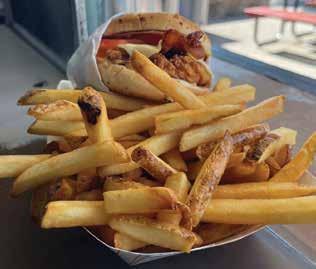

the sides, but check out the mac-and-cheese bites. Of course, all of The Summit’s seasonings, rubs and secret sauces are made “in house.”
Kids even have their own special menu, including corn dogs and chicken tenders, and drinks range from shakes and floats to sodas. Top off your meal with the stand’s ice cream sundae. For early birds, try a breakfast burrito or sandwich with your coffee. The restaurant also offers corn burritos, rated at the top of the charts by the “I Love Corn Burritos Group” which critiques corn burritos around the area on its Facebook page.
And, give The Summit a call to find out when its famous summer and fall weekend offering of special barbecue tri-tip is happening … that alone is worth the drive-up.
But Private Chef Dave, now via The Summit Drive-In, hasn’t stopped catering. In the valley, his food has graced wedding receptions, local AirBnBs, bed & breakfast inns, even private poker games, and special events at places around town, such as Boccali’s, Thacher School, and Monica Ros School. Recently, he catered the Rotary Club of Ojai’s 75th Anniversary party for 150 people.
The Summit, originally known as Fay’s Place, was built on the crest of the dividing line of Upper Ojai and Santa Paula in 1961, and has ever since been a burger stand and watering hole for Ojai residents, hikers and bikers, tourists, or travelers just out to enjoy the scenery.
A bit of Summit lore: Family and friends’ happy moments and memories are nurtured there. One story Dave likes to tell is, back in the day when The Summit was Fay’s Place, a reform school was across the street. One dedicated teacher would often take one of her students to Fay’s Place for lunch where they would bond over burgers and fries. The reform school has since closed and Fay’s Place became The Summit Drive-In, but over those years, the teacher and her student stayed connected, and not long ago recreated their lunch experience at The Summit, sharing moments and memories.
The Cagnacci family are fourth-generation residents of Ojai and Ventura with roots in the food business going back to the early 1900s.


The Summit Drive-In, run by “a team of family and friends who love to run a restaurant and cater to folks who like to entertain,” has survived the Thomas Fire that started nearby and which devastated the neighboring landscape. Firetrucks parked in the restaurant’s lot allowed firefighters to keep an eye on its survival. Then the pandemic hit.
But this iconic burger joint was kept alive with the help of a steady stream of longtime customers.

On a personal note, The Summit Drive-In brings back so many joyful memories of my first burger shack/stand experience with its outdoor picnic-esque atmosphere. I love trying this joint’s new
cheeseburgers and crispy chicken sandwiches … so much so, I’ve been known to order one of each when I’m there (a dietary habit that keeps me going to the gym). Drive out and drive up to the drive-in with family or friends. No doubt, you will create your own memorable moments and joyful memories.







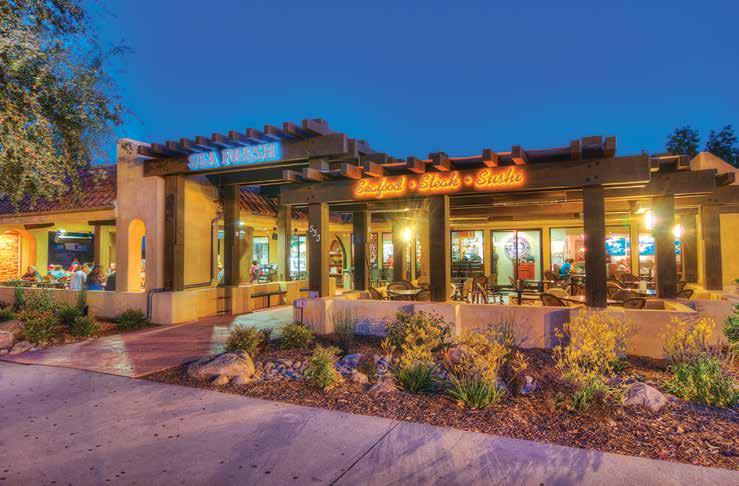











At the top of a hill with outstanding views, this unique 5br/5ba Midcentury modern with a Spanish influence was remodeled and upgraded in 2022 to a state of near perfection. 20-foot ceilings and facing glass walls frame the mountains while the airy great room opens to an ultra-modern kitchen and an expansive covered porch by the lush, private pool area. The two acre lot also has an ideal location for a separate guest house.
276RunningRidgeOjai.com
Offered at $4,450,000




Over 25 years of experience matching people and property in the Ojai Valley









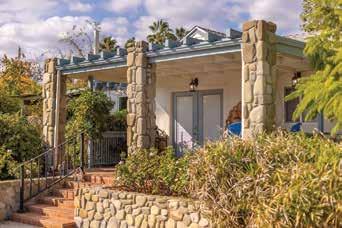












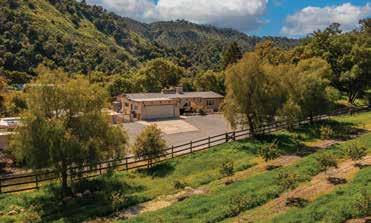

$4,458,000



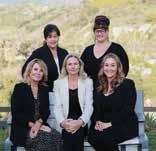

Exquisite upgrades throughout this Arbolada home. 3 bedrooms, 2.5 baths of approx. 2,350 sf on an almost 1/2-acre lot. Highly desirable area within easy walking distance to downtown and shopping. Peaceful mountain views. Attached guest studio with its own entrance and private rear deck. Every square foot of this property, inside and out has been upgraded with high end finishes. Custom cabinetry, granite counters, gleaming original wood floors and tile floors. Stone walkways and majestic oaks. Detached oversized two-car garage insulated and drywalled.
$2,200,000


Wonderful lot in very desirable Ojai’s Arbolada. Nice mountain views from rear of property and a park-like setting. Sewer lateral at rear of property. 3’ and 2’ underground conduits to property corner. Casitas water allocation. Level lot with slight slope at rear. $799,000












SEPTEMBER 15—16, 2023

A FUNDRAISER FOR THE OJAI VALLEY LAND CONSERVANCY

Lights, camera, conservation! Ojai Valley Land Conservancy (OVLC) proudly presents our 9th annual Mountainfilm on Tour. Experience the beauty of nature, the thrill of adrenaline-pumping adventures, and the power of environmental storytelling as we showcase a carefully curated selection of films from the Mountainfilm Festival in Telluride at Ojai Valley School.
Scan the QR code or visit ovlc.org to learn more and purchase tickets »
VIRTUAL AUCTION - RAFFLE - LIVE MUSIC - FOOD TRUCKS

THIS EVENT IS SPONSORED BY Fiona Hutton & Associates
All proceeds help protect & restore the natural landscapes of the Ojai Valley forever.


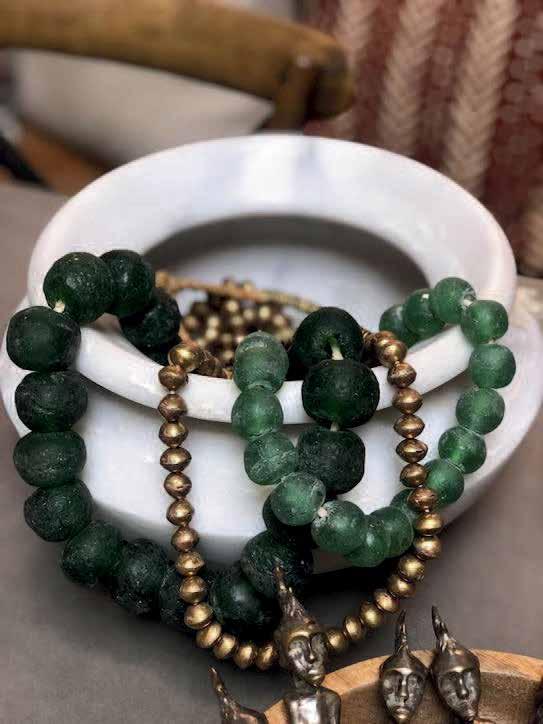



Check out the smartphone app GoVCBus for stop-time arrival predictions.


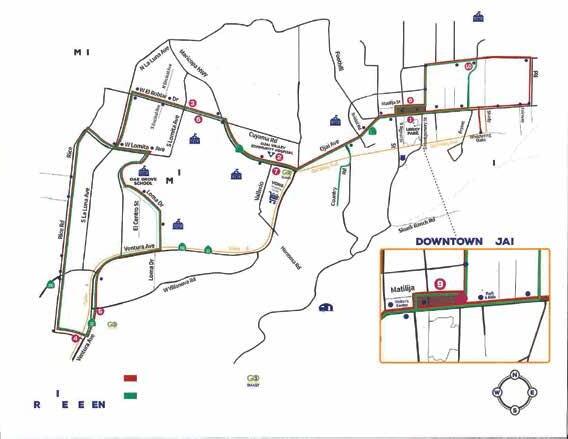














life, it helps to be cute. Especially if you’re a dog.
I speak from experience. If you Google “most adorable dog in the world,” your search will turn up a small poodle named Diggity who lives at our house. He looks like a little black lamb, snuggles against you to snooze, and has an excellent sense of humor.


Diggity Dog technically belongs to my wife, Merry, who likes to tell his origin story. A friend saw a classified ad for “miniature poodle, black,” and we drove to Ventura to check him out. The address turned out to be a bail bonds storefront in a strip mall.
“We’re just here to look,” said Merry to the girl behind the counter. “Not to buy.” The girl leaned down to a basket and lifted out a little black fuzzball. When Merry reached for him, he immediately laid his head against her heart.
“Uh, how much?”
“$158,” said the girl — apparently the price of a bail bond? (Today if Diggity misbehaves, we remind him he could be a little more grateful about our springing him.)
Diggy is a good traveler, so it was only natural to take him with us to Carmel-by-the-Sea, often touted as the most dog-friendly town in America. The town rolls out the stain-proof red carpet

for its canine visitors. Dogs are welcome at many hotels, as well as restaurants with patios. Shops put out water bowls. Pooches are permitted to romp off-leash on Carmel Beach.
We strolled down Ocean Avenue, the main shopping street of this town known for its fairytale cottages and window boxes of cascading flowers.

Every two seconds, it seemed, we met another dog with a person
on a leash. An apricot poodle followed its owner into a shoe boutique. Next came two sleek Italian greyhounds walked by an equally sleek couple. A silky white Lhasa apso rounded the corner, saw Diggy, and began leaping and flirting. It was like a scene from “Lady and the Tramp.”
Dogs serve as icebreakers, prompting conversations with strangers. “What breed is he?” “How old?” Kids looked at little Diggy and asked, “Can we pat him?” Sure, we’d say, and they’d properly extend the back of one hand to be sniffed, then scritch him behind the ears.
One outgoing ten-year-old boy wanted to pet Diggy, but our doglet was distracted and paid no attention. “He rejected me!” said the boy, laughing.
“Yes,” said Merry, “take that with you through life.”
On our wanderings we discovered some of Carmel’s hidden passageways and courtyards. The village has more than 40 of them, lined with cafés, galleries, jewelry shops, and boutiques. (Tip: If you lean toward cashmere, you’ve found your spot.)

On a previous trip we’d visited the now-closed Rodrigue Studio, one of nearly 100 art galleries in the single square mile of Carmel village. Diggy wanted to go because it was the home of the famous Blue Dog paintings by Louisiana artist George Rodrigue. He was inspired by the French-Cajun legend of the loup garou, a sort of ghost dog of the bayou. You’ve probably seen the artist’s depiction: a blue pooch with big pointy ears, staring directly at you. The dog might sport a polka-dot necktie, sit before a gothic mansion, or be accompanied by a red alligator.
Blue Dog paintings start at around $60,000, so maybe it’s best the gallery has closed and I didn’t have to disappoint our fuzzy little art patron.

down to Carmel Beach, a wide slope of white-sugar sand. From here your view sweeps from rugged Point Lobos to the south to the manicured golf links at Pebble Beach to the north. Lumi-

nous aquamarine waves rolling ashore looked ready-made for a painter’s seascape.
The beach was active but serene — tots with sand pails, mothers chatting, and all kinds of dogs. Free of their leashes, some raced through the cool shallows — ah, the paws that refreshes! Two recent acquaintances, a small pug and a big black lab, chased round and round. You’ve never seen so many dogs having so much fun.
We also walked the packed-dirt path leading from Ocean Drive along aptly named Scenic Road. On one side we rubbernecked at spectacular houses, and on the other admired the craggy shoreline and gnarled cypress trees.
After a time Diggy suggested we head back to our hotel for a rest. The Cypress Inn, a 1929 Spanish-Moorish hotel with thick white walls, was co-founded by the late singer and actress Doris Day, a longtime champion of animals and a pioneer in pet-friendly travel since the 1980s. Her love of animals explains why you can check in with any kind of critter. Besides dogs and cats, the guest register has included a pot-bellied pig, a parrot perched on its owner’s shoulder, and a three-foot-long iguana. “Que Sera, Sera!” sang the star in her 1956 hit. “Whatever will be, will be.”
Until her death in 2019 at age 97, Doris Day lived in nearby Carmel Valley. The sunny blonde with the sunny voice is still a presence at the inn; the walls are decorated with her silver-screen posters and television sets stream her old movies, such as “Pillow Talk.”
The very definition of “casual but elegant,” the inn’s living room seems right out of a movie star’s Beverly Hills mansion. It has a lofty wood-beamed ceiling, a big fireplace, a grand piano, conversational groupings of chairs and loveseats, shelves of books, and


doors streaming light from the patio.
Merry, Diggy, and I adjourned to our second-floor room, whose Juliet balcony overlooked a courtyard. A complimentary decanter of cream sherry greeted us, while Diggy got a water bowl, dog treats, and his own plush blanket to curl up on. We all took a little nap.
Merry and I had reservations for dinner downstairs at Terry’s Lounge, and on the way led Diggy through the bar. The room was packed with Carmel locals, many with pooches, who come for the inn’s “Yappy Hour.” All the dogs got along, and no bar(k) fights broke out.
We were seated in a patio where bougainvillea and red camellias grew against white walls. Diggy’s first pal was Toby, a wirehaired fox terrier at the next table. Cream colored, he was a ringer for Asta, the famous canine scene-stealer in the classic 1930s “Thin Man” movies. Upon seeing Diggy, he stood up on his hind legs and waved his front paws in greeting.
There was lots of doggie crosstalk between tables, and even guests who hadn’t brought pets took out cell phones to share photos of their dogs back home. A German shepherd sat near us, socializing with a cocker spaniel whose golden fur closely matched its mistress’s blonde tresses. If I squinted, I could almost imagine it was Doris Day.
As our own little four-legged ambassador eagerly met the nearby dogs, and we met their people, I realized something: We thought we’d be introducing Diggy to Carmel. But it turned out he was introducing us.
Carmel-by-the-Sea is 272 miles north of Ojai, about a 4.5-hour drive via U.S. 101 to CA 68 and CA 1.
carmelcalifornia.com. A visitor center in Carmel Plaza (Ocean Ave. between Junipero and Mission) offers maps, brochures, and info on hotels, restaurants, and wine tasting; in the courtyard, the Fountain of Woof is a canine watering spot.
carmelcalifornia.com/dog-friendly-carmel has links to pet-friendly hotels and restaurants.
CYPRESS INN (Lincoln and 7th St., 831-624-3871 or 800-443-7443, cypress-inn.com) Luxurious yet easygoing, the inn has 44 rooms and suites, some with fireplaces, verandas, and/or Jacuzzi baths. Fine linens; evening turndown service includes chocolates and dog biscuits. The staff is warm and helpful.
Breakfast features fresh berries, excellent scrambled eggs, new potatoes with onions, and trademark puffy popovers. Rates from $229 to $689. Pet fee $30; $50 for two; $75 for three. Pet sitters available.
TERRY’S LOUNGE serves locally sourced Monterey Bay and Mediterranean dishes. I liked the sesame-crusted seared ahi tuna with soba noodles and julienne vegetables. Cocktails draw inspiration from the 1920s-40s.
HOFSAS HOUSE (4th and San Carlos, 831-624-2745, hofsashouse.com)
This pet-friendly, budget-friendly inn, family run for 75 years, is a few blocks from central Carmel but out of the bustle. There are 37 simple but well kept rooms with Dutch doors and some fireplaces, balconies (distant ocean views), and kitchens. Pool, continental breakfast. Manager and co-owner Carrie Theis, who has sat on the city council, is a trove of tips for enjoying Carmel with your dog. Rates from $175 to $595; pet fee $30 per night per pet.
For offerings check the link under “Dog Friendly,” above. I especially like: ANTON & MICHEL (Mission St. between Ocean and 7th, 831-624-2406, antonandmichel.com) Creative California cuisine. We had lunch in a sunny courtyard: sand dabs (me), ahi tuna salad niçoise (Merry), and caramel-and-sea-salt crème brûlée (both of us, to avoid dueling spoons). Our friendly waitress spotted Diggy under the table and brought him a bowl of water.
THEforwarded e-mail that I was reading, sent to me by a friend, initially surfaced from a group of birders from San Luis Obispo on the evening of January 2, 2022. That day the group had been birding hard on the Carrizo Plain National Monument.


As usual, those semi-arid grasslands produced a throng of raptors and other migratory songbirds, but their biggest prize didn’t reveal themselves until later that afternoon. December 2021 was a wet month, with just enough rain to fill Soda Lake, a large alkali lake on the northern fringe of the national monument.
As the sun sank behind the Caliente Mountains to the west and shadows crept across the grasslands toward the Temblor Range,
three gangly sandhill cranes flew in and waded through the shallows of Soda Lake. Sandhill cranes hadn’t been documented on the Carrizo Plain since 2010.
I received that e-mail early on January 3, 2022. After reading it, I packed up my camera gear and binoculars and headed straight to Soda Lake hoping for a glimpse of these elegant, red-capped cranes.
As usual, I drove Highway 150, rounding Lake Casitas before connecting with Highway 33 through Ojai. The winding road up and over Los Padres National Forest has always been my favorite route out to the Carrizo Plain. There’s little or no traffic through the scrubby chaparral and pine forests before reaching the sweeping semi-arid grasslands.
Leading up to 2010, sandhill cranes, waterfowl, and throngs of shorebirds relied on Soda Lake as a winter stopover during their annual migration along the Pacific Flyway. However, following the winter of 2010, California sunk into a severe drought that lasted until February 2017, a solid seven years without water on



the consistently parched Soda Lake. There’s been other wet winters since, 2019 and 2020, come to mind, and of course 2022-23 was monumental. However, inconsistent rain has forced sandhill cranes to search for reliable alternatives during their annual migration.
On the afternoon of January 3, I scoured Soda Lake and its salt-encrusted shoreline for any signs of these long-legged cranes. On several occasions I thrashed through tangled saltbush concealing muddy shorelines not visible from Soda Lake Road.
By late afternoon, with the sun sinking beyond the Calientes, I sat atop the Soda Lake Overlook anticipating a couple of sandhill cranes flying in to display their impressive wingspans, their wingtips appearing like fingers on a hand.
It was another flawless sunset spanning across the Carrizo Plain, a pack of coyotes howling unseen in the background, and several pronghorn antelope sauntering eastward beyond Soda Lake. Unfortunately, though, no cranes were spotted, but my curiosity wandered. Where do sandhill cranes go in winter? It’s somewhere nearby on the southern edge of the San Joaquin Valley.
It was barely light at the Pixley National Wildlife Refuge (NWF) several miles west of Highway 99, just north of Bakersfield, a region of California transformed by decades of agriculture. Yet, on a map, there are still some postage stamp-sized


habitats that are havens for wildlife. Pixley NWF is 6,939 acres, a remnant of marsh and grassland biome clinging to the San
As soon as I left my truck, I could easily hear the loud, rattling “kar-r-r-r- o-o-o” vocalizations carrying across the refuge cloaked in tule fog, the male and female sandhill cranes all trumpeting in unison. As soon as the sun rose above the tule fog, there were hundreds upon hundreds of cranes lifting off, flying east/northeast just for the day to forage on grass and ag lands. At sunset they return to the wetlands to roost overnight in the shallow waters to avoid any predators.
There’s an easy 1.5-mile walk from the carpark to an overlook revealing the wetlands that are shared by thousands of water-

fowl and shore- bird species such as northern shovelers, killdeer, black-necked stilts, white-faced ibis, Canadian and snow geese, American coots, but also close to 6,000 sandhill cranes!
Pixley NWF wasn’t my first encounter with a sandhill crane. That took place in the Arctic National Wildlife Refuge in north-

east Alaska in late June, 2013. After rafting the serpentine flow of the Canning River, I found myself on a barren, gritty barrier island overlooking chunky icefloes drifting westward across the frigid Beaufort Sea.
While traipsing across spongy tundra in hopes of spotting some large megafauna, I heard the odd “kar-r-r-r-o-o-o” carrying across the refuge.
Sure enough, a lone sandhill crane landed nearby me. It turns out during the late spring, summer, and early fall, sandhill cranes can be seen at their breeding grounds in Minnesota, Wiscon- sin, and Michigan. Others breed in Oregon, Idaho, and yes, as far north as Alaska.
Sandhill cranes are large birds ranging from just over three feet to four feet tall. They weigh seven to eight pounds with a wingspan that is just over six feet wide. Their young remain with their parents for 9-10 months, so they accompany them during their long migration. Sandhill cranes can live for 35 years.
“You here to see the sandhill cranes?” asked the bearded, disheveled refuge worker. “This is the best place to see them in this region of the state.”
I told him about the recent report of a few cranes visiting Soda Lake on the Carrizo Plain back on January 2. He seemed surprised.
“Because there hasn’t been reliable water at Soda Lake since 2010,” he continued, “all the cranes that wintered on the Carrizo Plain come here.”
It all made sense. Water is life for so many species, and the ponds and wetlands at Pixley are fed by annually allocated waters thanks to the 1992 Central Valley Project Improvement Act. A well was drilled in 1994 supplying reliable, sufficient flow for 300 acres of seasonal wetlands.
“Wait until sunset when the cranes fly back from where they were feeding,” he said.




He was right. The sandhill cranes didn’t disappoint. In the late afternoon, I walked back out to the convenient overlook. I never saw another soul the entire day on the refuge, the incessant trumpeting of cranes never waning. Their rattling calls only increased as sunset approached, squadrons of them filling cool, crisp winter skies as the sun sank on the western horizon.
It was good to know where they migrate to, where they congregate and rest over the winter, a postage stamp of a wetland surrounded by agriculture. However, I’ll always keep an eye on Soda Lake, in the hopes sandhill cranes rediscover that natural alkali basin.


“We specialize in biomimetic principles. Biomimetic dentistry is the reconstruction of teeth to emulate their esthetic and natural form and function. It is the most conservative approach to treating fractured and decayed teeth — it keeps them strong and seals them from bacterial invasion. By conserving as much tooth structure as possible, we can eliminate the need for many crowns and root canals.”

JACALYN BOOTH
Certified Colon Hydrotherapist
Ojai Digestive Health
With more than 30 years of experience in healing modalities, Jacalyn brings a deep level of caring to the art of colon hydrotherapy. Professional, nurturing, experienced.


OjaiDigestiveHealth.com
805-901-3000
DR. NANCY DOREO
is a naturopathic doctor and chiropractor specializing in Applied Kinesiology. Modalities include: IV therapy, Homeopathy, Flower Essences, CranialFacial Release, Gentle Manipulation, Acupuncture Meridians, Massage Therapy.
DrDoreo.com
805-777-7184
AUBRIE WOODS
A graduate of USM's Master’s Program in Spiritual Psychology, a Certified SafeSpace trauma facilitator, and certified Theta Healer. Trained in pre-natal support, transformational parenting, pleasure mastery, relationship and intimacy coaching, chakra clearing, and Inquiry Method. AubrieWoodsCoaching.com
NUTMEG’S OJAI HOUSE
Functional Art for Heart & Home - American MadeFair Trade - Psychic Tarot and Astrology Readers, Energy and Crystal Healings daily by appt. Walk-ins welcomed: Open daily 11 a.m. to 6 p.m. 304 N. Montgomery Street

OjaiHouse.com | 805-640-1656
LESLIE BOUCHÉ, C.HT.
Cert. Hypnotherapist
Find your calm center. Release negative thinking, emotional reactivity, anxiety, fear and unhelpful behaviors. Improve sleep and comfort. Safe, loving, rapid change. It’s time to feel better! leslie@lesliebouche.com LeslieBouche.com | 805-796-1616
LAURIE EDGCOMB
Lic. Acupuncturist since 1986, voted best in Ojai! Natural medicine including Microcurrent, nutritional and herbal consultation, Facial Rejuvenation.


LaurieEdgcomb.com
805-798-4148
DR. JOHN R. GALASKA
Dr. John R. Galaska, PsyD, BCN, Cht, university professor of Psychology, Neurofeedback, biofeedback, hypnosis for past troubling experiences and enhancing subjective life experience. BeCalmOfOjai.com facebook.com/BeCalmofOjai
MICHELLE BYRNES
Elemental Nutrition
Nutrition & Wellness counseling focused on anti-aging, detoxification, personalized nutrition, & weight loss. For more information, visit elementalnutritioncoach.com

805-218-8550
LAUREL FELICE, LMT
Offers Swedish, deep tissue, reflexology, reiki, cranialsacral and pre and post natal massage with a reverent and joyous balance of hands and heart. laurelfelice54@gmail.com
805-886-3674
SECURE BEGINNINGS
Pre-birth to 3; pre/post-natal wellbeing; infant/toddler development; parent education/support. SecureBeginnings.org info@securebeginnings.org

805-646-7559
VIBRANT WELLNESS
MASSAGE
We bring a specialized massage that takes a holistic approach to treating stress in the body, all from the comfort of your home or office. With skillful hands & intuitive heart each session will unlock your inner Vibrant Wellness. VibrantWellnessOjai.com
916.204.9691
805-705-5175 TO ADVERTISE HERE: plEASE cAll OR EmAIl DAVID TAylOR AT david@ojaiquarterly.com OR 805-798-0177
JULIE TUMAMAITSTENSLIE
Chumash Elder Consultant • Storyteller • Spiritual Advisor • Workshops Weddings & Ceremonies





JTumamait@hotmail.com
805-701-6152





SEPTEMBER 16
Mountain Film on Tour
Date: Saturday
Times: Gates open at 5 p.m.
Films start at 7: 15 p.m.
Location: Ojai Valley School’s Lower Campus sports field, 723 El Paseo Road
Contact: Adam@OVLC.org
The 9th annual Mountain Film brings together the best outdoor films to benefit the Ojai Valley Land Conservancy. Advance tickets are $35, $25 for OVLC members.
SEPTEMBER 21-23
Ojai Peace Days
Dates: Thursday to Saturday
Locations: Thursday Ojai Farmers Market, 3 to 7 p.m., Friday peace meditations throughout the Ojai Valley, Saturday Peace Concert at Libbey Bowl, 5 to 8 p.m.
Ojai has been recognized as an International City of Peace.
OCTOBER 7-9
Ojai Studio Artists Tour
Dates: Saturday
Times: 10 a.m. to 5 p.m.
Locations: More than 70 artist studios in the Ojai Valley. The event is headquartered at the Ojai Valley Museum, 109 Blanche Street
Contact: OjaiStudioArtists.org
888-645-5006
OCTOBER 20 TO MARCH 4
“Ojai Mystique”
Location: Ojai Valley Museum, 130 West Ojai Avenue
Times: Friday to Sunday, 10 a.m. to 4 p.m. Contact: 805-640-1390
OjaiValleyMuseum.org
This special exhibit features 21 nationally renowned artists with their interpretations of one place, Ojai.

OCTOBER 21
Ojai Day
Date: Saturday
Time: 10 a.m. to 4 p.m.
Location: Libbey Park
Contact: OjaiDay.com
805-646-5581
The community comes together to celebrate each other. Activities include bounce houses, face painting, cultural activities, animal education, live music, car and trailer shows, food trucks and more.
OCTOBER 26-29
Ojai Storytellers Festival


Dates: Thursday to Sunday
Times: Multiple Events
Locations: Ojai Art Center
113 South Montgomery Street
Contact: OjaiStoryFest.org
This decades-old Ojai tradition begins with a Meet the Tellers reception Thursday, 3:30 to 5 p.m. at the Ojai Art Center, with with Noa Baum, Reverend Robert Jones Jr., Peter Cook, Vijai Nathan, Niall de Burca, Carmen AgraDeedy and Tim Lowry.

NOVEMBER 2-6
VIRTUAL: NOV. 7-19
Ojai Film Festival
Dates: Thursday to Sunday
Times: Varied
Locations: Varied
Contact: Info@OjaiFilmFestival.com
805-640-1947
Since 2000, the Ojai Film Festival has celebrated cinema with dozens of screenings and special events.
NOVEMBER 11-12
Holiday Home Tour & Marketplace
Dates: Saturday & Sunday
Times: 10 a.m. to 4 p.m.
Locations: Varied
Contact: Info@OjaiFestival.org
805-640-2094
The Ojai Music Festival has hosted tours of Ojai’s most distinctive, and distinguished, homes for 26 years.
THURSDAYS
“Ojai: Talk of the Town” Podcast New episodes out Thursday evenings.

all the things that have never happened, this never happened the most. The place it didn’t happen was Libbey Park in the small town of Ohwhy.

It all started during the Big Troubles at Little City Hall, which had been going on for some time. At one particularly fractious council meeting, a small, oddly dressed boy, a stranger to all and with no responsible adult in sight, stood up and with wide eyes and a clear, piping voice said “Can’t everybody please just get along?”
Well, it was hard for the furious adults present to ignore such a plea from one so young and innocent, especially one who was carrying a knapsack on a pole and smoking a pipe — which accounted at least for his piping voice. And, because it is Hollywood narrative imperative that a room full of angry grown-ups stops to listen to the clear-eyed wisdom of a small, charismatic child, a thick, expectant silence descended on the chamber for the first time in many a baying meeting.
“In the northwest corner of Hyde Park in London…” the small boy said (People later said the his unnerving aspect was due to his fixed smile and preternaturally long fingers. And a little bit the pipe.)
“…There is a place,” he continued, smiling. “It is called Speaker’s Corner and, day or night, all manner of mankind may have twenty uninterrupted minutes at a time to speak their truth, whether it be political; religious; revolutionary; a gofundme pitch for their ground-breaking poetry; recipe-based; a plea to save the bees/the earth/
for a comfortable retirement; one could give a speech that’s gluten-free, verb-free or even reason-free - the unhinged are also welcome. Whatever moves you, you may speak about and be heard. Karl Marx and George Orwell spoke there and countless others in a great tradition of free speech.”

“Sometimes,” the odd boy continued with the sort of intonation that tells you some oratorial flourish is about to happen…“Sometimes, when a town is at loggerheads, the arguments are just a proxy for what is really going on in people’s hearts.” (Smiling, smiling, fingers, fingers) “Sometimes people just want to get things off their chest, un-named things, perceived slights or the generalized worry that Elon Musk is going to say or do something else tomorrow. SOMETIMES people just need to be heard!” he cried. Following the rhetorical crescendo of the sentences beginning with “Sometimes” the little boy mopped his brow and sucked hard on his pipe. “ Why not give everybody their soap-box?” he said. (Smile. Fingers. What was the deal with this little boy?) “Not just the loudest people, or the most confident! Let everyone get it all out of their stifled brains before they show up for council meetings and it might make for a more peaceful town!”
There was a silence. The little boy smiled his particular smile and curled his peculiar fingers.
“Well, here was an experiment that was worth trying!” the assembled agreed, each shining in the new strangeness of not actively loathing each other. Townspeople nodded and smiled at each other and it lasted a full, golden minute until the little boy slipped out unseen, taking his unsettling aura with him. (Were there extra knuckles in his fingers? Nobody was sure. He seemed wrong somehow. Wrong in the way an 8-year-old boy being called Cyril is wrong. You couldn’t explain it.)
Then, naturally, the chamber was back to normal-sized finger-wagging and you-mark-my-wordsing; the impassioned remonstrations of some designed to undermine the meticulously curated cynicism of others, and vice versa. But the idea stuck! At the next council meeting the motion to create Ohwhy’s first ever Speakers’ Corner was passed and thus the town entered one of its most interesting and revealing episodes. It would last only six months.
At first it was a roaring success. All sorts of people showed up to the freshly built Podium of Oration at Speaker’s Corner in Libbey Park and no day was ever the same. Soon a lively little industry of food vendors had sprung up to feed the crowds that thronged the park.
1. Only residents of the Ojai Valley could speak. Other towns could get their own damn Speakers’ Corner, ran the thinking.
2. No one may heckle the speaker during their allotted time.
3. No-one may heckle the speaker during their allotted time. Public refutations to speeches were allowed but only if the refuter had already booked a time slot. Arguments amongst onlookers were, of course, allowed and participation was enthusiastic so a permanent first-aid station was quickly established to attend to the subsequent black eyes, mashed noses, and, at least once, a multiple puncture-wound situation: the unhappy result of internecine strife within the Ojai Embroidery Bee. (A lapsed and disenchanted embroiderer had stood up to ask in despair “What even is the point of embroidery any more in a world on fire?” and, after her allotted 20 minutes, the enraged embroidery faithful answered her, pointedly. About 53 times according to the nurse.)
All sorts of information and disinformation was disseminated at Speakers’ Corner. Opinions, business pitches, dissatisfactions, homilies, lists of motivational affirmations, and speeches of every flavor. One old woman got up to just tell people interesting facts, like the Latin word for raisin is ova pasta which literally means “a grape that has suffered” and emus can’t walk backwards. An endearing, young couple got up and shared their idea for a movie with a view to securing initial funding.
“We haven’t worked out the details yet,” they rhapsodized “But it starts and finishes with a drone shot! We’re super excited about it!” they said, turning to each other, getting lost in each other’s shining, hopeful eyes. “Awww” said the audience as one, and by the end of the day the couple had their first $5,000 and somebody’s uncle to lawyer for them.
Many people showed up time and time again.
LUNA BLITHELY was a regular in the early morning slot and commanded her own loyal audience, Mostly it was stream-of consciousness stuff as she shared her truths and whatever. She always spent the first 10 minutes of the time arranging bits of her own hard foot skin and dried macaroni into a circle around her in a mandala entitled “Meditation in Yellow.” Then she would recite her free-form stream-of-consciousness poems interspersed with soft recorder toots. Example:
“I stepped outside and inhaled deeply of the day” she intoned. (Toot)
“I saw the toiling snail upon the path and I validated him. (Toot) I watched the simple pigeon upon the wing And knew
That by embarking on this vision quest I was becoming one with the pigeon,
Both of us pilgrims of the biosphere, seekers of the universal Light! (Toot)
I watched an even simpler pigeon fly into a window and the Sickening crunch
As it made impact roused in me a profound awakening of what could be:
Potentialities!
And what sometimes sadly couldn’t be: Pigeons.
It was an invocation of Being manifest in expanding wave-forms! (Toot)
I turned and bowed to the nodding dandelion and marveled aloud at my own big-toe-hair!
How amazing that Nature has evolved for me my own personal toe-warmer!
I heard sniggering.
It was the UPS guy but I minded him not because he obviously hadn’t supped from the Well of Life.
I thought some more about the aggregating of all souls and Just then (toot)
A hawk flew by with a Terrified screaming rabbit in its talons (Piercing toot!) And then sacredly,

And only slightly nauseatedly, I sank to my knees and
Became one with my English muffin.” (Toot)
For sure, Luna was a tedious listen some mornings, but most people showed up on the off-chance she might have tantric sex right there on her yogic pillow, which she sometimes did.
THE OJAI BDSM ENTHUSIASTS were also at the park faithfully each week, smiling and handing out pamphlets with helpful instructions and new positions to try. Well, you couldn’t tell if they were smiling beneath the gimp masks but they really were surprisingly friendly for perverts, you had to admit. One enthusiast, Mistress LaTourniquet, brought her macramé plant-holders to sell, a lively appreciation for knotting having first prompted her entry into the BDSM world. On casual Fridays they all showed up in their regular clothes to try to normalize the image of BDSM for their neighbors. “Destigmatization is key!” chirped Ms. Jennifer Slippers, librarian, having swapped her latex cat suit (eared) for some smart JP Penney slacks and a mallard-themed blouse. Nobody had told her dachshund, Onion,
about the no-interruptions rule though. Onion suffered terribly with his anal glands. His pitiful whining and woeful peering round at his tail often cut short the BDSM agenda but, on that day, the top BDSM brass felt they couldn’t be polite any more and demoted Ms. Slippers as public representative on the spot. As she was led away visibly weeping, tantric Luna Blithely took over for the remaining speech time. Luna, who delighted at the variety of new kinds of people she was meeting at Speakers’ Corner, joined all the groups, except the Pickleball Society. She didn’t like the way they moved.
All sorts of people showed up to listen, and all abided by silence for 20 minutes, before generating a cacophony of debate and hot-dog sales between speakers. What a great and civilized institution Speakers’ Corner was! Council meetings were indeed much more cordial now everybody was purging their complicat-
ed modern feelings in the park! God bless that odd wee boy!
Of course, inevitably, some speakers were less popular than others. One day, there appeared a breathtakingly-bosomed, impeccably hand-bagged woman in a rose, satin pant-suit carrying a wheezing chihuahua which squinted very much like a recent former first lady.

The woman’s name was MEDEIRA VON B’STARD, and she was spotted often in the smarter restaurants in town with a tiny, mean-eyed, grey little creature that might be a man. People assumed it was her husband or brother but it could have just as easily been a large and wicked mouse. They were never apart, never spoke to each other, and never tipped.

looked like he could unhinge his lower jaw to devour your family dog. The bad-eyed Mouse Man trotted behind. All simmered in impotent fury as they walked past the Mexican restaurant. Then it was time for the next speaker and, once again, the mood that had dominated the park, as she spoke, changed completely.
By and by, word spread and first the national and then world press showed up to see what this strange little town was doing now. Not for the first time, everyone wanted what Ohwhy had got.
On any given day, as “LE MONDE” reported, one could find a middle-aged man of some sort telling us what we’re all getting wrong about crypto-currencies with all the rapier wit of a whiskyed uncle trying to explain the plot of a Bond movie; or a pimply young woman sharing how she had solved the problem of her smelly blender by running it for just 5 minutes with 3 parts vodka to one part grapefruit and a dryer sheet. She also had many useful tips about raising goats and lowering cows. With just one small urine sample and a chicken feather she could tell if you were dangerously inflaming your gut with ultra-processed foods or were simply in love. She was very popular, said “Le Monde.”
Medeira had blinked precisely once in her life and never planned to again. Her sharp, perfect little teeth glinted in the sun and the Post Office tower reflected in her enormous sunglasses as she purred out a robust defense of fascism and its role in the creation of a bold new national order where heiresses of all kinds could once again own staff without having to be embarrassed.
She argued that the owning of staff actually provided them with many useful skillsets they would never have learned had they not been owned. She maintained that a state could only really be happy when everybody knew their place. At the end of her speech she received a rousing cheer from up to two people. People watched uneasily as she stalked expensively back to a white stretch Hummer between her bodyguards, one a sort of deep-sea fish that had somehow got into a suit, and the other a fellow that
THE NEW YORK TIMES told their readers about a goateed man in white pajamas and a thatch of chest hair with the potential to keep back Wagner forces for months, who would show up exhorting townsfolk to buy his pore-reducing “Ruff Alpha Scruffboi Serum for Men,” made from Sespe-sourced mushrooms, humanely-sourced buffalo-semen, and Matilija Canyon-sourced manliness. The East Coasters ate it up.
THE LOS ANGELES TIMES reported on one speaker who had lived through the twin horrors of the Vietnam War and Marcus Albert’s ’70’s ballad “Feelings,” and was trying to warn us about the very real dangers of Big Kombucha, a scandal that went right to the heart of our nation’s capital and threatened our American way of life. The scandal was about to break any day now and if
we didn’t listen to the Truth right now, we’d all be sorry. “Beware!” he would cry, non-specifically. And sometimes, but much more quietly, “Help!”
THE OJAI QUARTERLY had a piece on a young man in a bow tie who looked like he transformed into a Volvo at every full moon and would show up to tell us where we were all getting it wrong on the “Who was more evil: Hitler or Stalin?” question. “Neither!” he said triumphantly looking around for the gasps from the crowd that never came. “I bet you’re wondering who could possibly be worse!” he cried with eye-swiveling glee, confident that he was about to deliver a truth so big it would blow these idiots’ minds, these flabby-thinking people with their pointless labradors and stupid, warm, loving home-lives. “Well as a matter of fact…!” he droned on as 20 minutes seemed to loop and bend and expand to seven hours for the audience and several people set fire to their hair. Nobody cared who he thought the person more evil than Hitler and Stalin was. Nobody could understand why he remained unpunched.
A man with a 4-o’clock shadow like a singed fishcake who was letting beige corduroy carry a lot of his personality would bring his own bullhorn and tell all Libbey Park about the benefits of Fear in the daily battle of life.
He was the sort of man who might proposition you in the elevator of a budget hotel in Iowa. A life governed by Fear and Avoidance, he counseled, could add a full seven more years to
one’s life. We were living in the blighted husk of omnicidal late stage capitalism and soon it would be everyone for themselves. Fear is good. Suspicion is good. We are right to be fearful about a great many things, he said, and should definitely buy some of his protective talismanic amulets which double as concealed firearms to protect ourselves.

He gave no fewer than 83 examples of what we ought to be fearful about at Von’s alone, and a further 7 if we use a trolley.
His own wife, God bless her, had lost her talisman, panicked in Ben Franklin’s, then lost her mind and was now confined to their home spending her days buying double-quilted bed-jackets from eBay. His weaponized amulets sold briskly after his speeches because, everyone agreed, you can’t be too careful these days.
One earnest OUTER HEBRIDEAN WOMAN would come by fortnightly, frantically telling anyone who would listen about … well nobody knew about what. Her dialect was incomprehensible although quite musical, in the way that a steel girder falling from a great height might accidentally hit a middle C. Nobody knew much about her only that she had earned a great deal of money in the twenty-teens by inventing the haggis emoji. Whenever she was finished speaking she would bolt from the podium, like a cat out of a burning litter-tray, pupils dilated and running at breakneck speed towards something only she could see. Nobody would have been surprised had she asked them to hide a warm gun. The UNDOING OF SPEAKER’S CORNER took 91 minutes and 14 emergency vehicles, all in all. It started when a hodge-podge band of scrappy idealists in combat
gear tried to set up a rival speaker’s corner. Nobody knew if there was a rule against that and so an ad hoc committee was set up by the fountain to explore the question. Within the committee though was an armed faction of die-hard council meeting-goers who missed the good old days of being the ones with all the opinions. Their tentacles reached into the crowd, pitching citizen against citizen and the grumbling grew louder.
Suddenly the Sea-Shanty Revivalist Club charged at the Early Birds Power-Walking Association. Pretty soon, the compost demonstration group were throttling members of the BDSM Enthusiasts, who weren’t actually fighting back that hard… The Citizens for Safe Crosswalks, an already dangerously unstable quasi-military splinter group of Keep Ojai Clean with known ties to radicalized council meeting-goers saw their chance. It was shillelagh law. But you don’t bring a shillelagh to a shoot out. The New York Times would later call it a heart-rending scene of blood and rogue civic participation.
From high above OhWhy on Shelf Road, the Outer Hebridean
looked down upon the far-off Battle of Libbey Park as juice-cartons and chairs and exploding amulets and small dogs and skis (skis?) sailed silently up into the air and down again. Whatever the truth is, she thought, nobody’s therapy is working.


He was never seen again but about a year later reports came in about sightings of a strange, long-fingered boy right before a riot broke out in a small town in Oregon. Conspiracy theories abounded. He was obviously sent by the government/MAGA/ The Rothschilds/The Gays/The Chinese to wreak havoc in small American towns. Was he AI-generated? What was up with these fingers? But he had mopped his brow! Androids can’t sweat, right? He must be someone’s stolen child, groomed by Hillary to sew discord in the country. The truth, people said, would be dynamite in the wrong hands. Only people who had done the actual research and watched the right You Tubes knew what was really going down. “People,” said other people smugly, “Cannot handle the truth.” And those other people said the same about them.


magical, nearly hidden downtown location. The front house is a 5br/3.5ba 3500sqft Mediterranean with balconies, high ceilings, large windows and a guest suite with kitchenette. In back is a 2,123sqft 1920s cottage in an oak grove that could be potentially three separate rentals or a large secondary home for offices, studios or guests.

300WSantaAnaStOjai.com

Offered at $4,200,000

Over 25 years of experience matching people and property in the Ojai Valley


